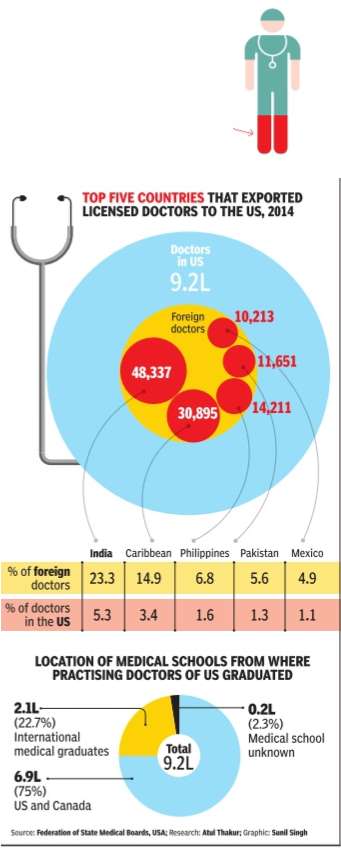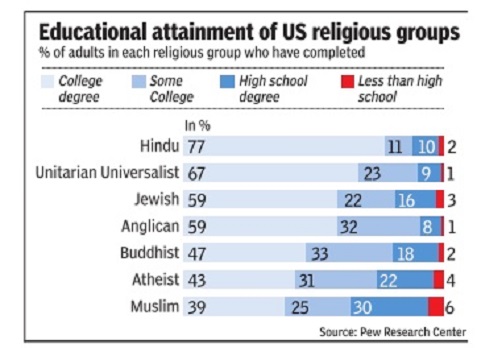Indians in the USA
This is a collection of articles archived for the excellence of their content. |
An overview
As in 2020, 21
NYT News Service, August 26, 2021: The Times of India
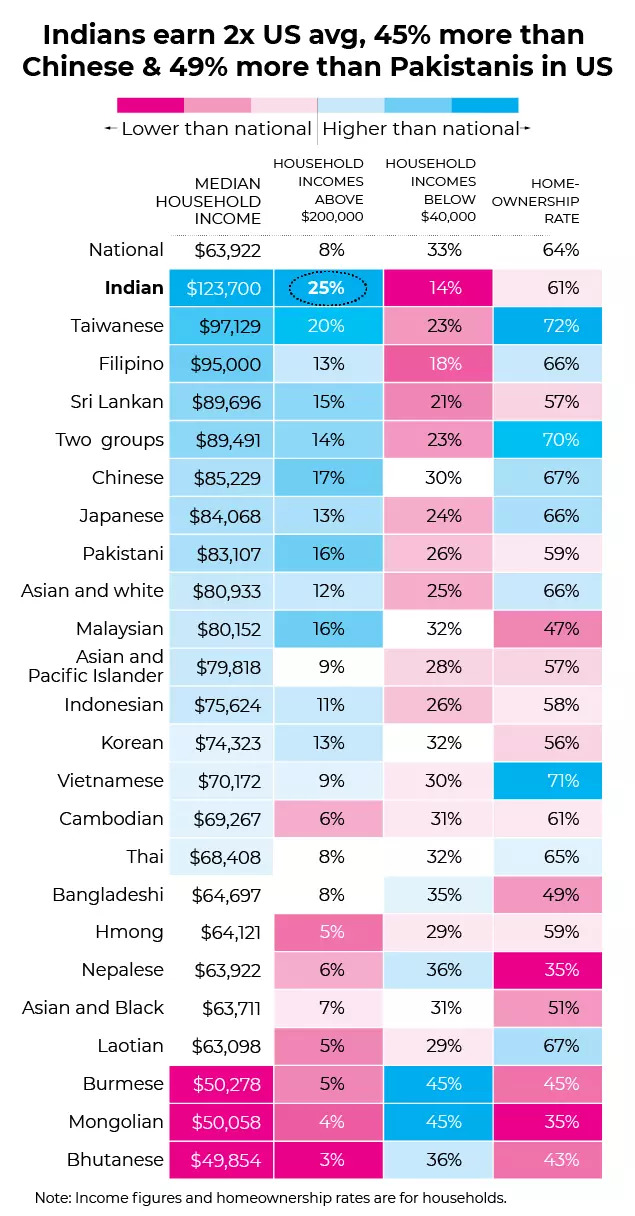
From: NYT News Service, August 26, 2021: The Times of India

From: NYT News Service, August 26, 2021: The Times of India

From: NYT News Service, August 26, 2021: The Times of India

From: NYT News Service, August 26, 2021: The Times of India

From: NYT News Service, August 26, 2021: The Times of India

From: NYT News Service, August 26, 2021: The Times of India

From: NYT News Service, August 26, 2021: The Times of India
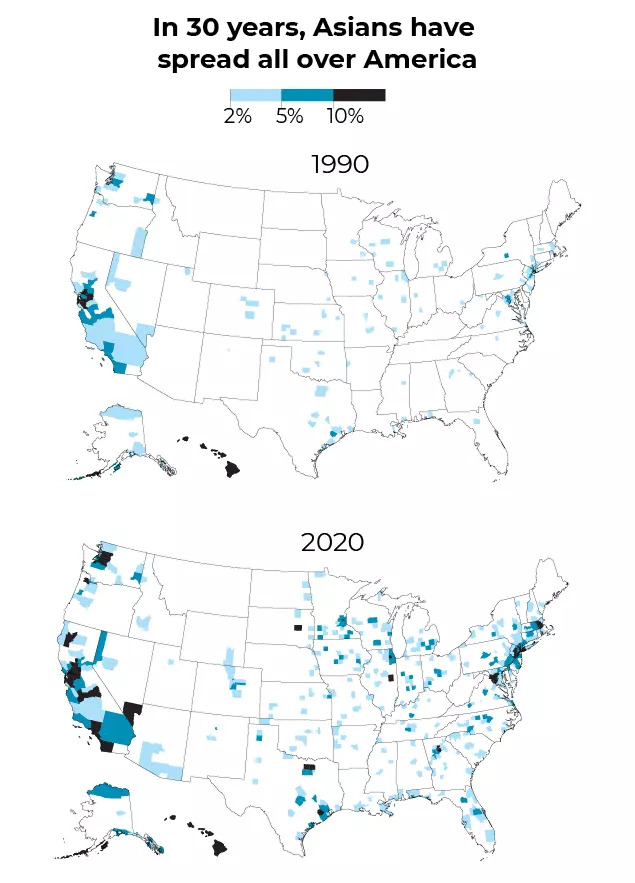
From: NYT News Service, August 26, 2021: The Times of India
The number of people who identify as Asian in the United States nearly tripled in the past three decades, and Asians are now the fastest-growing of the nation’s four largest racial and ethnic groups, according to the US census numbers.
But in addition to the uptick, the Asian population has become geographically diverse with wide variations in income, age, citizenship status, political preference and other demographic categories, according to a New York Times analysis of census data.
Even within groups, there are wide gulfs between the characteristics of new immigrants and those who were born in the United States or who were naturalised many years ago.
Asians have higher income, among them Indians the wealthiest
For example, the household incomes of people of Asian descent exceed the overall US population’s household incomes. Educational attainment is similarly higher. But among groups, there is quite a large variation.
Economically, Indians are consistently wealthier, while residents of Bhutanese descent have the lowest income and are unlikely to own a home. Many are Nepali-speaking Bhutanese refugees, who were stranded for years in camps with limited access to education.
In a census tract in Montgomery, Alabama, where the arrival of a Hyundai Motors assembly plant in 2005 jump-started the growth of a Korean community, 1 out of 3 people is Asian, and they include auto company executives and independent grocers.
Disparities in incomes are driven by the types of jobs held by different groups and the number of earners per household, which vary by citizenship status.
A disproportionate share of workers in healthcare are people of Filipino descent. But there are even more workers of Filipino descent with jobs in the service sector, particularly those without US citizenship.
Among Korean households, those headed by a person born in the United States have a median income of $95,000, but ones headed by Koreans who are not citizens have a median income of just $54,000. The gap is even wider for those of Chinese or Taiwanese descent.
Diversity among groups and within groups
In fact, the diversity of the US' Asian population often gets overlooked. Most published statistics consider all Asians as a single entity, but the reality is more nuanced.
In addition to Asians of a single race, an additional 3.5 million people identify as mixed-race Asian, making up more than a quarter of all mixed-race people in the United States.
Nearly 60% of all people of Asian descent, including those who are mixed race, were born outside the United States, and a majority are naturalised citizens. A vast majority of Asians in the United States are citizens, either naturalised or US-born.
People of Indian descent hold a significant share of jobs in several high-paying fields, including computer science, financial management and medicine. Nine percent of doctors in the United States are of Indian descent, and more than half of them are immigrants.
Dr Nihit Gupta, a child psychiatrist, and his wife, Dr Shikha Jaiswal, a nephrologist, who are Indian, have practiced in West Virginia since 2016. “This place really embraces us. The whole state is underserved, and they value our work,” said Gupta, 38, one of two psychiatrists within a 70-mile radius.
The couple had their first child, a son named Tasmay, 20 months ago.
Asian Americans born in the United States tend to be younger — half of them are children. They are the children of older, naturalised citizens who immigrated to the country a generation before.
How Asians voted
As a growing group in American demographics, Asian Americans are also playing an increasing role in electoral politics.
Analysis by NYT found that neighborhoods with high concentrations of Asian residents overwhelmingly favored Joe Biden in the 2020 presidential election, though variations exist among different groups. More than half of places where Vietnamese Americans were a majority, for example, favoured US President Donald Trump in 2020.
Asian population, including Indians, has grown, more spread out The Asian population is complex, made up of nearly 20 million people who trace their roots to more than 20 countries in East Asia, Southeast Asia and the Indian subcontinent — regions that the Census Bureau includes as places of origin for Asians.
In 1990, the country’s Asian population numbered 6.6 million and was largely concentrated in a few pockets in cities on the coasts. Thirty years later, those enclaves have grown significantly, and the Asian population is more spread out, with families building lives in the suburbs of the South and in rural areas of the Midwest.
The number of counties where people of Asian descent represent more than 5% of the population has risen to 176 in 2020 from 39 in 1990.
“When people think Asians in America, they think California, Hawaii. But this population is not a West Coast phenomenon. It’s now an American phenomenon,” said Neil G Ruiz, the associate director of race and ethnicity research at Pew Research Center. North Dakota, South Dakota, Texas, North Carolina and Indiana are among states that experienced major growth in the past decade. And people of Asian descent have been settling in ever larger numbers in states like West Virginia, where the overall population has declined.
With the Asian population continuing to expand at a fast clip, demographers expect it to surpass 46 million by 2060. The story has been edited for the TOI+ reader
Methodology To assess the demographics of Asians in the United States, The Times analysed recently released 2020 census results and compared the figures with those of previous decades. For more detailed characteristics of Asian groups, the analysis used microdata from the 2019 American Community Survey, obtained from the Minnesota Population Center. The primary statistics from the 2020 census were based on people who identified as non-Hispanic and Asian of a single race. The data is based on how people described themselves in the survey, but may not necessarily reflect where they were born or immigrated from. The Census Bureau defines Asian as anyone with origins from East Asia, Southeast Asia or the Indian subcontinent. To get the broadest picture of Asian characteristics, the American Community Survey analysis included Asians who identified themselves as either Asian from a single group or Asian in combination with another race. The analysis divided the US Asian population into 24 subgroups and further divided these groups by citizenship status — native-born citizens, naturalized citizens born outside the United States and immigrants who are not US citizens.
Asylum seekers
2017: 7,000 applicants
Over 7,000 Indians sought US asylum in 2017: Report, June 21, 2018: The Times of India
Over 7,000 people from India filed applications for asylum in the US last year, according to a report by the UN refugee agency which said America was the largest recipient of new asylum requests in 2017.
The UN Refugee Agency said in its annual Global Trends report that 68.5 million people globally were displaced as of the end of 2017. Among them were 16.2 million people who became displaced during 2017 itself, either for the first time or repeatedly.
Wars, other violence and persecution drove worldwide forced displacement to a new high in 2017 for the fifth year in a row, led by the crisis in Democratic Republic of the Congo, South Sudan’s war, and the flight into Bangladesh from Myanmar of thousands of Rohingya refugees.
Nationalities from which there were over 5,000 claims in 2017 were Mexico (26,100), China (17,400), Haiti (8,600) and India (7,400). Altogether, claims were received from nationals from 168 countries, the report said.
As per the report, there were 1,97,146 refugees as at 2017 end in India and 10,519 asylum seekers with pending cases. There are about 40,391 asylum seekers from India at the end of last year, the report said.
The highest number of asylum claims were filed by nationals of Afghanistan who submitted 1,24,900 claims in 80 countries.
2021-23
Ashish Chauhan, Nov 11, 2024: The Times of India
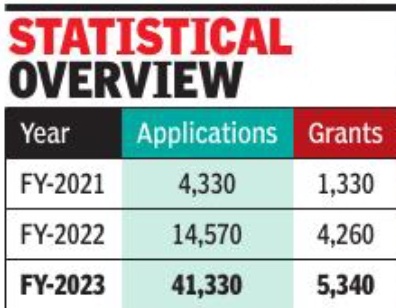
From: Ashish Chauhan, Nov 11, 2024: The Times of India
Ahmedabad : The number of Indians seeking asylum in the US has seen a significant jump in the past three years, a trend reflecting the strong lure of living the American dream. From 4,330 in the 2021 US financial year, the applicant numbers surged 855% to 41,330 in FY 2023, shows a US Department of Homeland Security data. Officials in Indian agencies say close to half of these applicants are from Gujarat.
In 2023, Indians were the fifth largest group in seeking defensive asylum and the seventh largest in affirmative asylum applications. That year, 5,340 Indians received asylum, states the 2023 Asylees Annual Flow Report of Department of Homeland Security released in Oct. The 4,330 in FY 2021 included both affirmative ap plications (2,090) submitted to the US Citizenship and Immigration Services and defensive applications (2,240). The next year, the total applicants nearly tripled to 14,570 — 5,370 affirmative and 9,200 defensive. By FY 2023, the number of Indian asylum applications surged to 41,330, again nearly three times the previous year’s total.
In FY 2021, as many as 1,330 Indians were granted asylum, including 700 through affirmative applications and 630 through defensive proceedings. In FY 2022, this number more than tripled to 4,260, with 2,180 affirmative and 2,080 defensive grants. The upward trend continued in FY 2023, with 5,340 Indians receiving asylum — 2,710 through affirmative cases and 2,630 through defensive proceedings, making India the fifth leading nationality for defensive asylum grants.
Citizenship
2017: 10% increase
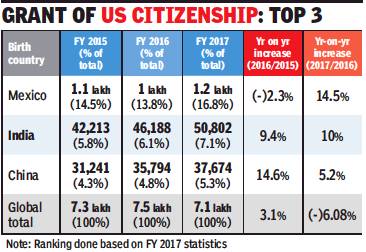
From: Lubna Kably, 50k desis got US citizenship last year, a rise of 10%, September 19, 2018: The Times of India
Even as the American dream is souring for many immigrants and those aspiring to become US citizens are now finding it tougher, Indians seem to be getting the softer end of the stick.
While there was a decline in the aggregate number of individuals who obtained US naturalisation (a drop of 6% in FY2017), it was a different story for India and Mexico.
According to data released recently by the US department of homeland security, during 2017, 50,802 Indians (10% growth) obtained US naturalisation, making them the second largest group after Mexicans on this count.
The naturalisation process confers US citizenship upon foreign nationals who have met relevant requirements. Post this, they obtain the right to vote.
Processing backlog is on the rise
The naturalisation upswing comes close on the heels of the reported 8.3 lakh growth in the number of Indian immigrants entering the US over the past seven years (see TOI front page report on September 17).
In aggregate, seven lakh individuals were conferred citizenship by the US government during the fiscal year 2017 (period between October 1, 2016 and September 30, 2017) of which Indians constituted 7%.
As compared to the previous year, 4,600 more Indians were conferred US citizenship during 2017. The report adds that the largest numeric increase in naturalisation occurred among immigrants born in Mexico (increase of 15,009, or 14%), India (4,614, 10%) and China (1,880, 5%).
Immigration experts say that those aspiring to become US citizens are now finding it tougher. There is extreme vetting of applications and an uptake in denials on “odd” grounds that date back many years. A spike in the number of applications, spurred by uncertainty on work visa policies, has resulted in a huge processing backlog in administrative offices across the US.
The US department of homeland security has provided aggregate data of the number of applications received over the years (a breakup based on country of origin is not available). With 9.87 lakh applications for US citizenship, 2017 saw a marginal rise of 1.5% over the previous year.
Backlog swells by 93% since 2015, activists file lawsuit:
Normally, only green cardholders can opt for the naturalisation process. While a green card is a permit to live and work long term in the US, the flux in visa policies and the focus on more jobs for citizens is inducing many green card-holders to opt for US citizenship, say immigration experts. However, the backlog in processing of citizenship applications is on the rise. According to the National Partnership for New Americans (NPNA), the naturalisation backlog has skyrocketed to 7.53 lakh applications, a 93% increase over the backlog prevailing in 2015.
NPNA and a few other associations filed a lawsuit on September 17 (which is celebrated as Citizenship Day in the US) as the US Citizenship and Immigration Services (USCIS) failed to respond to a Freedom of Information Act request, made in early August, to provide documents related to the backlog of citizenship applications.
“We are suing USCIS because the Trump administration has created a ‘second wall’ that is preventing lawfully present immigrants from becoming US citizens and voting. Whether this is a result of hostility to immigrants or wilful mismanagement makes no difference. It must stop,” Joshua Hoyt, executive director at NPNA, told TOI.
Added to the backlog woes is the spike in denials of naturalisation applications. “The grounds for denial are unpredictable, they could even relate to errors made when obtaining H-1B visas or green cards. This adds to the uncertainty,” Rajiv S Khanna, managing attorney at Immigration.com.
Diasporas from other countries vis a vis India
2019
Dec 17, 2022: The Times of India
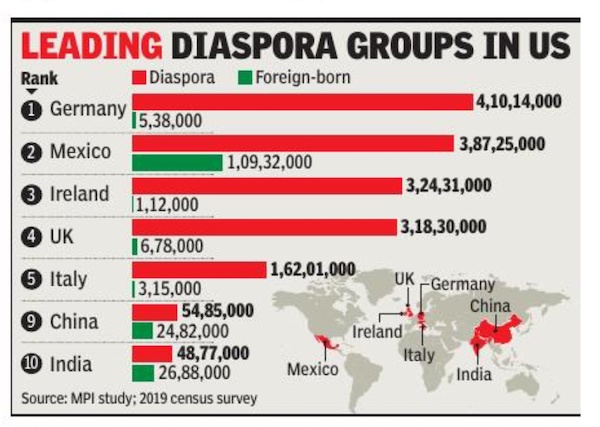
From: Dec 17, 2022: The Times of India
The Indian diaspora comprises approximately 4. 9 million individuals resi ding in the United States, who were either born in India or reported Indian ancestry or origin, according to a study released today by the Migration Policy Institute (MPI), a think-tank.
Indians rank tenth on the diaspora charts. The Chinese diaspora comprising of 5. 4 million is ranked ninth. The top three countries in the diaspora list are: Germany (41 million), Mexico (38 million) and Ireland (32 million).
However, Indians are the second largest immigrant group, following Mexico, and are the main beneficiaries of the non-immigrant H-1B visas for highly skilled individuals.
This study — ‘Spotlight on Indian immigrants in the US’ — points out that the 2. 7 million Indian immigrants living in the US as of 2021 made up 6% of the total foreignborn population, and their numbers continue to grow.
One of the reasons for this stark difference between the diaspora and immigration statistics is that immigration for non-Europeans opened up only post 1965.
Ari Joffman and Jeanne Batalova, authors of this MPI study, state that compared to all immigrants, Indians aremuch more likely to have arrived in large numbers since the year 2000 and beyond.
In 2021, the median age of Indian immigrants was 41 years, which is younger than the overall foreign-born population (47 years), but older than the US or native-born (37 years). Nearly 80% of Indian immigrants were of working age (between 18 to 64 years); versus 77% of the overall foreign-born population and 59% of those born in the US (native born).
Education levels of the Indian immigrants is also relatively higher. Their composition when it comes to advanced degrees stands out, the MPI’s study cites, as nearly 49% of Indian immigrant adults held a graduate or professional degree in 2021 compared to 15% of the foreignborn and 13% of native adults. This in turn reflects in the significantly higher median annual incomes.
In 2021, households headed by an Indian immigrant had a median annual income of $150,000, compared to $70,000 for all immigrant and native-led ones.
A lesser-known trend in Indian immigration is the rise in unauthorised arrivals at the US-Mexico borders, the study points out. Between October 2021 and September 2022, border authorities encountered Indian migrants 18,300 times at this border, a spike from 2,600 in the same period a year earlier.
MPI estimates that as of 2019, approximately 0. 55 million (5%) of the estimated 11 million unauthorised immigrants in the US were from India.
India vis-à-vis other source countries: 2020

From: January 11, 2022: The Times of India
See graphic:
Migrants from India and other source countries to the USA: 2020
2020, 2021
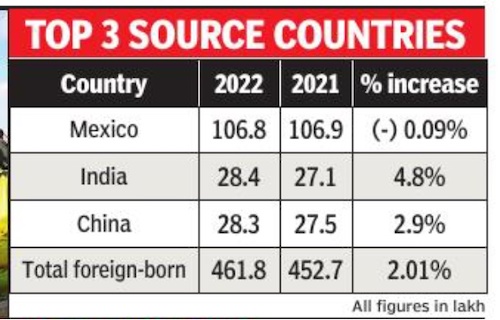
From: Lubna Kably, Sep 24, 2023: The Times of India
See graphic:
Indians, Chinese and Mexicans in the USA, 2020, 2021
Doctors
2014: Doctors of Indian (and Pakistani) origin
The Times of India Jan 09 2016
A majority of foreign doctors licensed to practise in the US are Indians who graduated from Indian medical schools. They constitute 23% of active foreign-educated physicians stthere.
lle of Notably, Osmania Medical College Hyderabad, with 2,118 doctors, ranranks 9th among the top 10 foreign medical cal schools whose graduates have active licences in the US
2023
Nurses
June 15, 2024: The Times of India

From: June 15, 2024: The Times of India
At 6%, Indians No.2 among immigrant nurses in US: Data
Pakistan rounds off the top three with 13,000 immigrant doctors (constituting 5% to the immigrant doctor population). New Jersey, Florida and New York were the top destination American states for immigrant doctors. Remitly, a US-based company that provides digital financial/remittance services, recently released its “Immigrant Healthcare Index” based on its analysis of data of the Migration Policy Institute (MPI) and US Bureau of Labour Statistics.
The data shows that of the 34.1 lakh actively employed registered nurses, 5.4 lakh, or nearly 16%, are immigrants. A significant number — 1.4 lakh Filipino registered nurses — are currently working in the US, meaning that 26% of immigrant registered nurses were born in the Philippines.
Indians (32,000, or 6%, of the immigrant registered nurse workforce) and Nigerians (24,000, or 5%, of the immigrant registered nurse workforce) ranked as the second and third most common immigrant nationalities in this profession. California, Nevada and New Jersey were the top destination American states for immigrant registered nurses.
Immigrants with a workforce of nearly 2.7 crore constituted 18% of total US healthcare workers. Indians with a total of 1.8 lakh healthcare workers comprised 7% of the total immigrant healthcare professional population. While India was a significant source country for doctors and registered nurses, it did not figure in the top five when it came to other occupations like nursing assistants, health aides, etc, resulting in an overall rank of three.
Filipinos, with a workforce of 3.5 lakh (or 13% of the total immigrant healthcare professional population), occupied the top slot, followed by Mexico which, with a work force of 2.7 lakh workers, constituted 10% to the total immigrant healthcare professional population.
Economic status
The Times of India, Nov 10 2015
Chidanand Rajghatta
In 9 US states, Indians biggest immigrant bloc
For the longest time, Red states and Blue states in America have typically referred to Republican and Democratic leaning states in political and electoral terms. But in the world of immigration and demographics, it turns out they illustrate dominant Hispanic (mostly Mexican) and Asian (mostly Indian) populations. Amid reports that indicate India and China are now starting to send more legal immigrants to the United States than Mexico, new data from the US department of homeland security shows that Asian Indians form the biggest group of naturalized Americans in nine states, mostly in eastern US.
Mexican-Americans still dominate the central and western half of the US, but the fact Indians have such a high concentration in so many states comes as much as a surprise as Chinese not being the top immigrant population even in a single state.
Overall, Mexicans remain the single largest group of foreigners who were naturalized as citizens between 2003 and 2013, the decade for which DHS has released annualized data. But by state, Mexicans are the biggest group in only 24. Among the remaining 26 states plus the District of Columbia, 10 other nationalities claim the top spot, as this map shows.
In nine states, Indians make up the biggest group of naturalized citizens. Those from the Dominican Republic, who nationwide topped those from China for the first time in at least a decade, are the biggest group in five states, the DHS data shows.
Each year, roughly betwe en 800,000 to a million immigrants become naturalized US citizens. By country , the biggest groups after Mexico are India, Philippines, Dominican Republic and China. In recent years, more and more Indians are taking up US citizenship. DHS data from 20032013 shows Indians taking up US citizenship growing from about 30,000 annually to more than 60,000 annually towards the end of the decade, accounting for some 500,000 Indians who became American citizens in those 10 years.
Although they are outnumbered in California by Mexicans taking up US citizenship, the Golden State still remains their #1 destination.But in nine other states, including New Jersey , New York, Ohio, and Maryland, Indian-Americans top Mexicans-Americans numerically in terms of taking up citizenship.
The DHS data also shows that more than 50% of the emigrating Indians are in prime earning age of 25-44, suggesting that the US is benefiting from giving citizenship to productive immigrants. Retirees and homemakers formed less than 10% of Indians who got citizenship in 2013. Some 35% of Indian immigrants who took US citizenship worked in management, professional, service, production and sales occupations.
A community of professionals
Indians in US vital for transformation: Nancy Powell
TNN Aug 9, 2013
CHENNAI: Despite constituting less than 1% of the US population, Indian-Americans form 3% of the country's engineers, 7% of IT workers and 8% of physicians and surgeons, US ambassador Nancy J Powell said on Thursday while describing the community as "critical in shaping bilateral ties".
She recalled the visit of Martin Luther King Junior to the Presidency College (Madras) where he addressed a public gathering in 1959. "Both Vivekananda and King awakened the national consciousness of the United States against discrimination on the basis of colour, race, ethnicity and gender," she said.
2000-24: some indicators
Saurabh Sinha, August 14, 2024: The Times of India
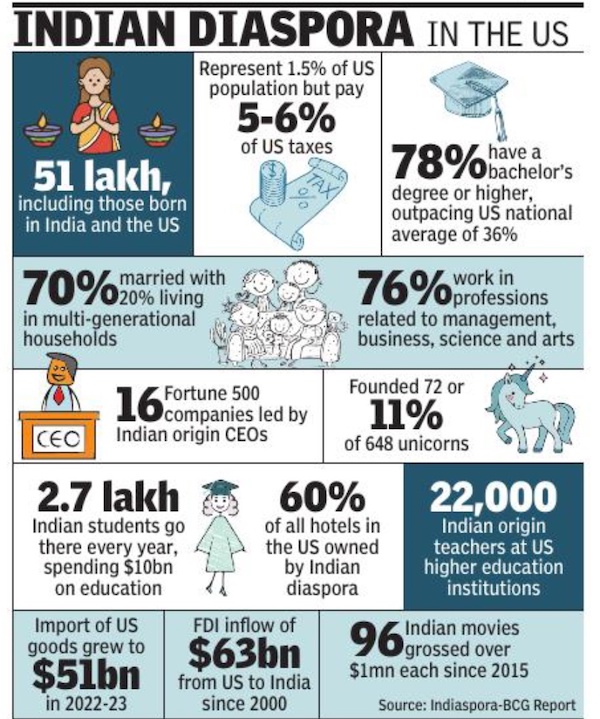
From: Saurabh Sinha, August 14, 2024: The Times of India
See graphic:
Indians in the US economy, 2000-24: some indicators
New Delhi : Whether it’s US VP and now presidential nominee Kamala Harris in the field of politics, Sunder Pichai and Satya Nadella in tech or astronaut Sunita Williams (to name a few), the undisputed rise of Indian-Americans has been acknowledged by all for some years. Now ajoint report by BCG and Indiaspora, a non-profit organisation comprising of global Indian origin leaders, has put solid numbers to this desi story in America: 51 lakh Indian diaspora at present has a median income of $136,000, which is almost double the US average and accounts for just 1.5% of the US population but pays 5-6% of US taxes.
The desi dominance is in all fields. “One in 10 physicians in the US is an Indian American, serving 30% of patients… 60% of all US hotels are owned by members of the diaspora, generating $700 billion in revenue and creating over 40 lakh jobs… Indian Americans own an estimated 35-50% of all convenience stores in the US, representing $350-490 billion in revenues each year…. Starting with one unicorn in 2010, India has seen exponential growth reaching 114 unicorns as of March 2024… India is the leading country of origin for immigrant-founded unicorns in the US in the last five years,” says the report titled “Small Community, Big Contributions, Boundless Horizons”.
While releasing the report, Union foreign minister S Jaishankar showcased the rise in his inimitable style. “When Pandit Nehru went to the US for the first time as PM, the Indian diaspora there was 3,000. When Indira Gandhi went there (first time as PM), the number was 30,000. When Rajiv went (same role), the number was 3 lakh. And when Narendra Modi went (same role first time), the number was 33 lakh. However, it is not just the quantity of the Indian diaspora but the quality and their skills, talent and contribution that has stood out,” said Jaishankar.
US ambassador to India Eric Garcetti, who flew into Delhi early on Tuesday morning from Paris on an aircraft that had many Indian Olympians, said: “This isn’t just a report of how Indians have influenced America. It’s a reflection of America itself. To know Indian Americans is to know America…. Kamala Harris is the first IndianAmerican to be one of the two main parties’ nominee for President of the United States…. If you want to see the future, if you want to work on the future, if you want to coauthor that future, come to India. If you want to see the future of America, understand the Indian-American community and you will see where we are going.” Cricket is going to be one of the sports at the LA 2028 Olympics.
The Indian diaspora is concentrated in California, Texas, New Jersey, New York and Illinois. However, not all is rosy and there are challenges too. About 6% live below the poverty line and 14% were undocumented in 2021, “making them the third largest undocumented migrant group in the country,” the report says. The H-1B programme “restricts the scope of available job opportunities and imposes longer-term uncertainties for those in the country on work visas.”
2015: Median household income for Indian-Americans: highest for any ethnic groups
The Times of India, May 02 2015
Chidanand Rajghatta

PIOs in US race past $100k mark
Indian-Americans have long been recognized by US agencies and socio-political cognoscenti as America's best-educated and wealthiest ethnic group. But a snapshot released by the US Census Bureau this week reveals that the median household income for Indian-Americans has crossed the $100,000 per annum milestone, the highest for any ethnic group, including white, native-born Americans.
In fact, the groundbreaking figure was crossed almost two years ago in 2013 but came to light when the US Census Bureau put it out as part of the AsianPacific American Heritage month which is celebrated in May.
According to the Bureau, the median income of households headed by the Asian population in 2013 was $72,472, much higher than the national median income of around $51,000. But even among Asian Americans, Indian Americans racked it up at $100,547, almost double the national median income, and significantly more than even white, non-Hispanic Americans whose median income is approximately $57,000. Indian-Americans also outearned other South Asian groups such as PakistaniAmericans ($63,000) and Ban gladeshi-Americans ($51,000).Previously, the Census Bureau's American Community Survey in 2010 had put the Indian-American median family income at $86,135.
In contrast to the highearning groups, the median income of Black-American households was $33,321 and that of Hispanic households was $39,005.
Though the census report did not address the religious angle, other surveys have long indicated that Jewish-Americans come closest to IndianAmericans in terms of income and education. According to a US Religious Landscape Study by Pew Forum on Religion & Public Life in 2008, 46% of Jews reported family incomes of over $100,000 compared to 19% of all Americans, with the next highest group being Hindus at 43%. And while 27% of Americans have had college or postgraduate education, 59% of American Jews have it, the second highest of any religious group after American Hindus.
Hindus top education and income charts
In US, Hindus top education and income charts, Nov 05 2016 : The Times of India
Hindus are shining in the US this Diwali season with recent surveys showing they are the most highly educated religious group in the country , and also a close second in terms of household income.
Some 77% of America's Hindus have a college degree -a good 10 percentage point lead over the next group, the Unitarian Universalists. Jews are a distant third with 59%, shows data from a Pew Research Centre study published on Friday .
Showing a strong correlation between education and in come, Hindus also make the second place in America in terms of household income.While 44% of Jews earn $100,000 or more per annum, 36% of Hindus are in the same income bracket. But taking mid and high incomes together (above $50,000 per annum), Hindus inch ahead with a total of 70% of their population, as against 68% for Jews.
Last year, Hindus became the fourth largest religious group in the US with a population of 2.1million, amounting to 0.7% of the country's population.
Indian women earn more than white men, less than Asian men
The Times of India Jan 08 2016
Washington
Indian-American women earn more on average when compared to nonHispanic white men in the US, according to a new report.
However, compared to Asian-American men, AsianAmerican women only make 78 cents on the dollar, which is the largest gender gap among the racial and ethnic categories studied, the report by US Bureau of Labour Statistics (BLS) said. The smallest gender gap was among AfricanAmericans -black women earn nearly 90 cents on the dollar compared to black men.
Education has a lot to do with the Asian-woman advantage. More than half of AsianAmericans over 25 have a bachelor's degree or higher, compared to only 33% of non-Hispanic whites.
About 72% of Indian-Americans have four-year college degrees, and a 40% have some professional or graduate degree. This means that IndianAmericans are more likely to have advanced degrees than white Americans are likely to have finished college, the `Washington Post' reported.
About 21.8% of Asian-Americans also have graduate or professional degrees, compared to 12.8% of non-Hispanic whites. This could explain the advantage that Asian-women have over men, the report said.
Economist Mark Perry wrote in his blog that Asian women working full-time earned only about 3% less per week ($841) than the average full-time male worker ($871) in 2014, according to the latest Bureau of Labor Statistics data. Asian women working full-time in 2014 earned more per week on average than black ($680) and Hispanic men ($616).
2016: co-found 14/ 87 billion $ startups
June 7, 2018: The Times of India

From: June 7, 2018: The Times of India
See graphic:
Billion dollar startups co-founded in the USA by immigrants from India, China and other countries
Immigrant entrepreneurs play a crucial role in the US startup scene. As of Jan 2016, 44 of 87 startups valued at more than $1 billion (unicorns) were co-founded by immigrants, creating an average of 760 jobs per company.
2016: Indians 2nd biggest group to get citizenship
December 1, 2017: The Times of India
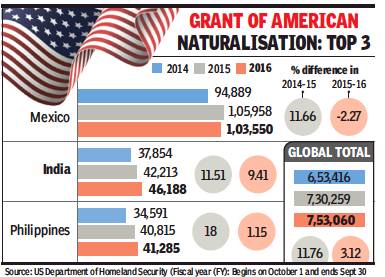
From: December 1, 2017: The Times of India
Nearly 46,100 odd Indians obtained US citizenship during 2016, making them the second largest group, even as Mexicans continued to top the chart. Indians accounted for 6% of the total citizenship conferredby the US government on 7.53 lakh individuals during the fiscal year 2016 (period between October 1, 2015 up to September 30, 2016), according to recent data released by the US department of homeland security (DHS).
A slight year-on-year decline in the number of citizenships being granted is visible, with immigration from Mexico showing a negative growth. The year-on-year increase in citizenship for Indians in 2016 was 9.4% against11.5% in 2015. Immigration experts say that those aspiring tobecome US citizens are nowfinding ittougher. There is an extreme vetting of applications and an uptake in denials on ‘odd’ grounds that date back many years. At the same time, uncertainty on work visa policies has spurred a significant spike in the number of applications. This has resulted in a huge processing backlog in administrative offices acrosstheUS.
The DHS has given aggregate data of the number of applications received over the years (a break-up based on country of origin isn’t available). With 9.72 lakh applications for citizenship (or naturalisation as it is referred to), the fiscal year 2016 saw a rise of 24% over the previous year. Comparatively, the 7.83 lakh applications in 2015 was just 1% higher than that in 2014.
Normally, only green card holders can opt for the naturalisation process. While a green card is a permit to live and work long-term in the US, the flux in visa policies and the focus on more jobs for citizens is inducing many green card holders to opt for US citizenship. “Indians, similar to other immigrants, now more than ever recognisethe valueof citizenship. A citizen has certain rights and protections — a fundamental right being that to vote. They also have additional job opportunities. Given the anti-immigrant rhetoric, immigrants are more aware of their needtobe protectedtothe full extent possible,” explains John C Yang, president and executive director of the nonprofit organisation Asian Americans Advancing Justice.
A report released in October by the National Partnership for New Americans (NPNA) states: The backlog of pending applications has increased by 77% over the past two years. At the end of June 2017, there were 7.08 lakh citizenship applicants waiting to be processed, up from 4 lakh applications at the same time two years earlier. The end resultis a waiting time of over a year, in many US states, to be sworn in as a US citizen, whereas two years ago, it averaged around 6 months. California, New York, Florida, and New Jersey, which are among the states with the highest backlog, have a significant number of Indians.
For many Indians, more than thedelay, itisthedenial of naturalisation that is worrying, as in some cases it can also adversely impact the existing green card status. “We also have concerns that applications have been unnecessarily subjected to inappropriate requests for follow-up information or investigations. Often, these involve family relationships or prior associations with employers or organisations that stretch years back. Some of these questions have gone back further in time than what we have seen before,” addsYang.
2017: Indians remain the richest
See graphic:
The median income of Chinese, Indians, Pakistanis and Sri Lankans in the USA in 2017; Biggest Asian groups in the USA; Biggest group of illegal immigrants from Asia in the USA

Biggest Asian groups in the USA;
Biggest group of illegal immigrants from Asia in the USA
From: September 17, 2017: The Times of India
2017: PIOs get key congressional panels
Desi lawmakers get key congressional panels, Jan 17, 2017: The Times of India
All five IndianAmerican lawmakers, the highest in the history of US congress, have been nominated to key congressional panels.
Ro Khanna, representing Silicon Valley , has been nominated to the House budget committee, while Pramila Jayapal, elected to the House of Representatives from Seattle, will serve on the House judiciary committee. Jayapal will also serve as a senior whip for the House Democrats and as vice chair for the Congressional Progressive caucus, where she will fight for solutions like a $15 per hour national minimum wage, comprehensive immigration reform, debtfree college, criminal justice reform, protecting women's reproductive rights and gun violence reform.
Raja Krishnamoorthi, representing Chicago, will serve on the House education and workforce committee. He said that his assignments would focus on job creation and affordable higher education.
Three-term Congressman Ami Bera has been renominated to the foreign affairs committee and science, space and technology committee. Bera is also co-chair of Congressional Caucus on India and Indian Americans. Kamala Harris, first Indian-American to have been elected to US Senate, has been made member of four powerful Senate committees -committee on budget, select committee on intelligence, committee on environment and public works and committee on homeland security and governmental affairs.
“These committees will be key battlegrounds in fight for the future of US. At a time when so many Californians and Americans are uncertain about our future, I will fight for our families and the ideals of our nation,“ Harris said.
2017: 40% decline in Indians looking for work in US
Oct 18, 2017:The Times of India
HIGHLIGHTS
There has been a 38% drop in Indians looking to move to the US.
Brexit may have led to 42% drop in Indians looking to move to UK.
Overall, there has been a 5% decrease in Indians looking to move abroad in search of job opportunities.
US president Donald Trump's anti-immigration stance and Britain's exit from the European Union last year have resulted in a lower number of Indians looking for jobs in these countries.
There has been a 38% and 42% drop in Indians looking to move to the US+ and UK respectively in the last one year (September 2016 to October 2017), compared to the corresponding previous year, data from job site Indeed showed. Overall, there has been a 5% decrease in Indians looking to move abroad in search of job opportunities, the report added.
The volatile political situations in developed countries have also made Indians look for jobs in their home country. The reverse job search to India has seen an uptick, with a 25% rise in people from the UK, the report said. The trend was even more pronounced for the Asia-Pacific region, with a 170% increase in interest in moving to India.
"This new data shows a reversal of the usual job search trend. The steadily growing Indian economy and political uncertainty abroad has per suaded skilled Indian talent to stay at home to find jobs and this in turn has fostered a thriving startup scene," said Sashi Kumar, managing director at Indeed India.
The report also showed that the prospect of Brexit could be deterring Indian job seekers looking to work in the UK+ . This has made them scout for other European countries such as Germany and Ireland, which has seen a 10% and 20% rise respectively from Indians in the same period, the report stated.
There has also been a 21% drop in the number of Indians looking to move to the Gulf because of the slump in oil price and economic slowdown in West Asia.
However, these same countries still figure among the top destinations for employees seeking job opportunities abroad. Despite the declining figures, the US still tops the list of countries that Indians would like to migrate to, with 49% of Indians searching for jobs overseas looking at the US. The other countries where Indians look to work include UAE (16%), Canada (9%), Great Britain (5%), Singapore(4%), Australia (3%), Qatar (2%), South Africa (1%) and Bahrain (1%).
2020: PIOs richest ethnic group
Chidanand Rajghatta, August 25, 2021: The Times of India
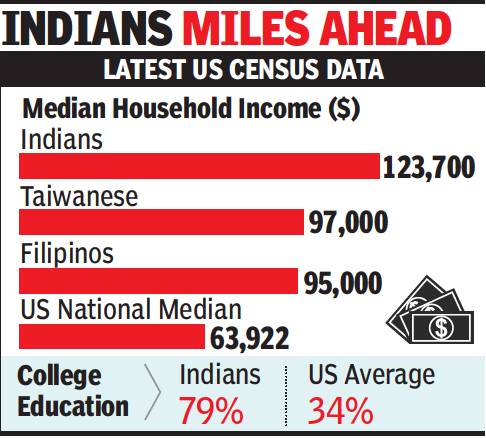
From: Chidanand Rajghatta, August 25, 2021: The Times of India
Indians in America, dubbed the “model minority”, continue their march to greater learning and prosperity, with the latest US Census showing them surpassing national metrics in college graduation and wealth by a wide margin.
The median household income of US Indians is now $123,700, almost double the national figure of $63,922. A massive 79% of Indians are graduates, compared to national figure of 34%, attesting to the emphasis on education in Indian families.
Indians comfortably outstrip even other Asian cohorts in US in median household income with the next best communities, Taiwanese and Filipinos, coming in at $97,000 and $95,000, respectively. Median household income of Chinese in US is $85,229 and that of Japanese is $84,068.
Indians also have the least poor with only 14% reporting median family income below $40,000 compared to 33% nationally. A healthy 25% of Indian households reported an income of over $200,000 compared to the national figure of 8%.
The census data shows that Indian immigrants on visas and US-born citizens of Indian origin have nearly the same median family income of about $115,000. Naturalised US citizens from India have a higher median income, $140,000.
As in 2023

From: June 17, 2024: The Times of India
See graphic:
The Indian diaspora’s contribution to the US economy, As in 2023
2014-2023: Indicators of PIOs’ success: and the backlash
Saubhik Chakrabarti, Dec 27, 2024: The Times of India
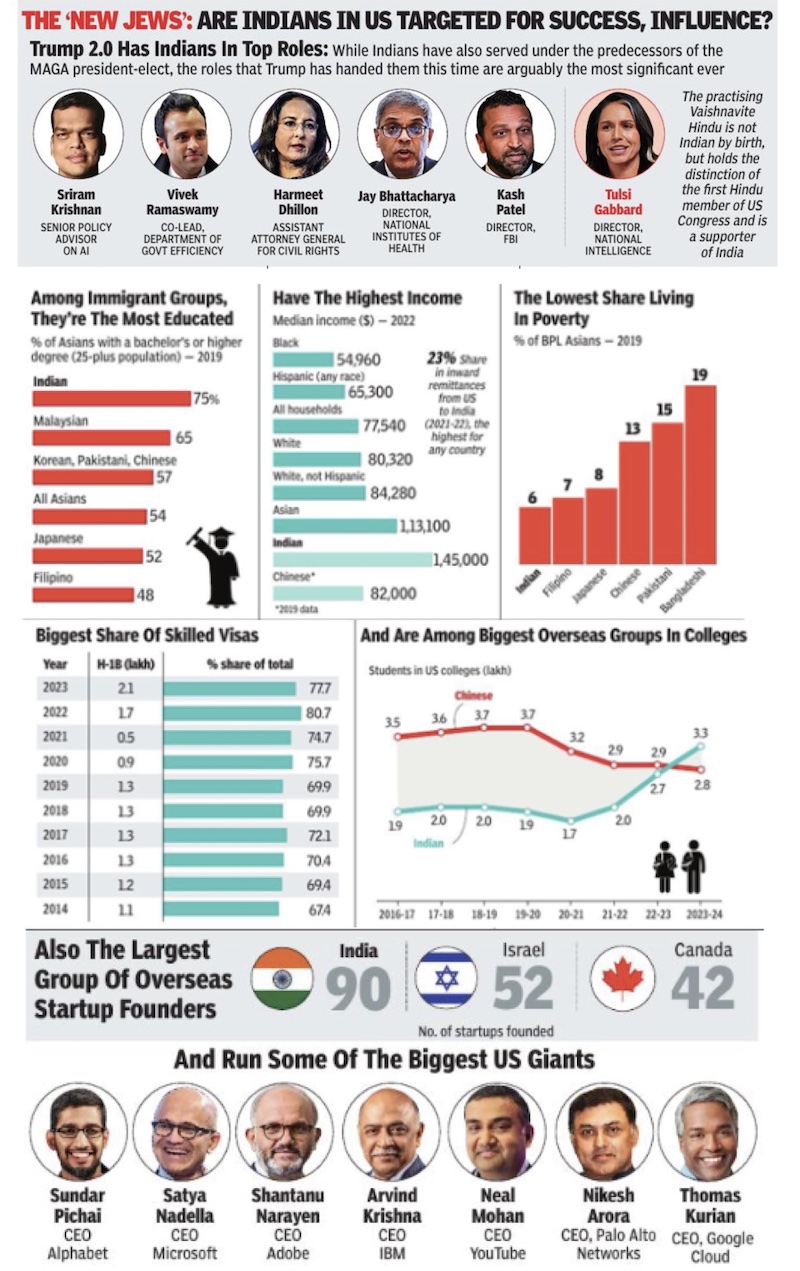
From: Saubhik Chakrabarti, Dec 27, 2024: The Times of India
“Our clout comes from the fact that the Indian community constitutes what I call the ‘next Jews’ of America: a highly successful, intellectually eminent, and economically prominent group that thrives in a merit-based, immigration-oriented society like America,” wrote Jagdish Bhagwati, a distinguished Columbia University professor, during President Bill Clinton’s visit to India in 2000. More than two decades later, the Indian diaspora’s influence and power have grown exponentially in the world’s largest economy. However, this admiration in some circles may be giving way to envy — or even hostility. The past 24 hours on social media have highlighted the possible shift. Here’s a quick look into the rise of Indians in America and why their success may be triggering a backlash
Arthur Calwell, a post-war immigration minister in Australia, would have faded into richly deserved obscurity — but, in the course of a parliamentary debate on Asian migrants in 1947, he uttered six words, and became forever (in)famous. “Two Wongs don’t make a White,” he said. Witty? Yes. Racist? Probably. Snappy, snarly riposte to those advocating liberal immigration? Certainly.
MAGA notables like Laura Loomer — among her gems is this: the only running water in India is what runs out of people’s asses — make Calwell look like a kombucha-drinking Berkeley liberal. For America’s Loomers, two Murugas from India don’t make a MAGA Yank, hell, 100 Murugas don’t make the cut, never mind that they are brainy techies.
That Indian Americans, many of whom are high-earning entrepreneurs and professionals, are in anti-immigration crusaders’ crosshairs isn’t as shocking as it seems to Indians and NRIs.
When blood-and-soil nativist nationalism gets charged up, it doesn’t make fine distinctions by looking at immigrants’ skill sets. It wants ‘foreign-looking’ people gone, Wongs or Wadhwanis. And to the extent well-off or wealthy white-collar immigrants have higher visibility than, say, blue or grey-collar ones (think Silicon Valley VC vs Nebraska motel owner), the former’s success feeds the envy factor.
But are we brown Indians lily-white on all this? We other our own kind (via caste, religion), we fulminate about ‘outsiders’ (Bangladeshis, Rohingyas).
● So, the first step in responding to threats to immigration is to list our failings, to which we must add the absence of serious Union-states joint ops against crooks who run the ‘Dunki’ routes for illegal immigration. GOI must convince US (and other Western countries) it’s cracking down on people trafficking. Minus that, it would lose half the argument on immigration before any dialogue begins. After being honest, be clever.
● Appoint a minister for immigration, a smart guy who has Modi’s ears and can be articulate in global settings.
● That mantri’s first job would be to find high-powered people in the Trump administration who have the creds to oppose MAGA group-think. Take Musk. He danced, belly button showing, with MAGA crowds. But he says skilled techies are vital for America. He’s also said quality American (presumably meaning white Americans) engineers are less motivated than their immigrant counterparts. There’ll be others, including those who see the sense in not reducing H-1B visas. Remember, whether it’s Biden or Trump, US Big Tech is a super-powerful lobby. But GOI shouldn’t ask the likes of Pichai, Nadella or Sriram (Trump-appointed AI advisor) to lobby for it. First, because they, rightly, wouldn’t do it. Second, because asking prominent Indian-Americans to speak for immigration would backfire massively. It will be a gift to Laura Loomer that’ll keep giving.
● The immigration mantri should also prepare a skills-based demand-supply list — skills US needs, skills India can supply. Techies, doctors, nurses, some blue-collar professionals.
● Label the skills: white collar (techies, doctors, STEM people), grey collar (nurses, lab techies, grunt software work), blue collar (plumbers, electricians, truckers).
● GOI should supply proof of skills (training in credible institutions/documented work experience) and state the number of potential immigrants.
● The list should be updated annually.
● GOI should also bat for temporary work visas, to address fears of Indians landing in the US and sticking around, looking for a green card.
Once his immigration mantri makes a smart pitch, Modi should talk to Trump. It’s unlikely Trump won’t listen, in part because Musk will be sitting in on that chat. You can’t ever convince Laura Loomer. What GOI should understand is that you don’t need to.
Green cards
2007-15
January 25, 2019: The Times of India
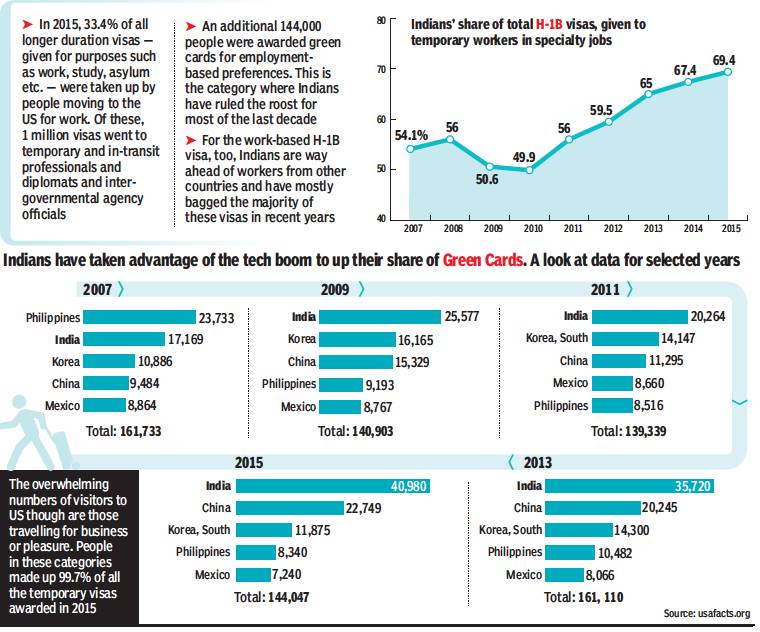
From: January 25, 2019: The Times of India
See graphic:
Green cards issued to Indians, Chinese and others, 2007-15
A per-country quota for Green Card means Indians face a huge backlog for landing permanent residency in the US. Plans by several US lawmakers to introduce a bill to eliminate this quota have led critics to argue that people from countries like India and China will corner the bulk of Green Cards. But Indians’ predominance in the work-related visa categories shows how they are the most sought-after professionals for US firms
2017: Over 60,000 Indians received green cards
Over 60,000 Indians received green cards in 2017: Report, October 18, 2018: The Times of India
Out of the over 600,000 Indians waiting for the most sought-after green card, only 60,394 have received the legal permanent residency last year which allows them to live and work in the US, according to the latest official figures.
Under the current regulation, skilled immigrants from India need to wait anywhere between 25-92 years for a green card due to per-country limits, said GCReforms.org, a website founded by members of the Indian diaspora living in the United States that focuses on immigration issues.
As of April 2018, there were 632,219 Indian immigrants and their spouses and minor children waiting for green cards.
Of the 60,394 Indians who received green cards in 2017, the maximum 23,569 were issued to the employment-based preferences like those on the H-1B visas.
Having a green card allows a person to live and work permanently in the US. Indian-Americans, most of whom are highly skilled and come to the US mainly on the H-1B work visas are the worst sufferers of the current immigration system which imposes a 7 per cent per country quota on allotment of green cards or permanent legal residency.
As many as 20,549 Indians were issued green cards in the capacity of them being immediate relatives (spouses, children and parents) of the US citizens, while 14,962 Indians were issued the green cards under the family sponsored categories like brothers and sisters.
The annual figures released on October 2 by the Department of Homeland Security (DHS), however, reveal that the number of Indians getting green cards has dropped - albeit marginally - than the previous two years.
In 2015, as many as 64,116 Indians were issued legal permanent residency, and the next year in 2016, the figure was 64,687.
Among the employment-based preferences - which is the route followed by the H-1B visa holders - 137,855 green cards were issued.
The DHS said around half of its green cards were issued to the immediate relatives of US citizens - spouses (292,909), children (74,989) and parents (148,610).
In all 1,127,167 million foreigners received green cards, which is a step below citizenship, in the year 2017, the figures revealed.
The previous year 1,183,505 foreigners received green cards in 2016 and 1,051,031 in 2015.
People from Asia (424,743) and North America (413,650) account for the maximum number of green card recipients in 2017.
Country-wise figures reveal that China topped the list with 71,565 green cards, followed by Cuba (65,028) and India (60,394).
However, India is different from other countries as it has the maximum number of people waiting in line.
Because of the Congressional mandated country quota, Indians according to Cato Institute, a libertarian think tank, would have to wait for decades and in some cases as much as 151 years to get a green card.
The figures also reveal that in 2017, Americans adopted 222 Indian kids, of which 176 were females and 46 males. Eight of these were of less than year old, 170 between one and four years, while 44 were over five years of age at the time of adoption.
2018: 75% of applicants for green cards are Indians
Over 75% of those waiting for green cards are Indians, June 8, 2018: The Times of India

From: Over 75% of those waiting for green cards are Indians, June 8, 2018: The Times of India
Indians account for more than three-fourths of those highly skilled professionals waiting in queue to obtain legal permanent residence status in the US, popularly known as green card, according to the latest official figures.
As of May 2018, there were 395,025 foreign nationals waiting for green cards under the employment-based preference category. Of these, 306,601 were Indians, according to the latest figures released by US Citizenship and Immigration Services. This does not include counts of dependent beneficiaries associated with the approved immigrant petitions, it said. Under the existing law, no more than 7% of green cards may be issued to natives of any one independent country in a fiscal year.
Indian-Americans, most of whom are highly skilled and come to the US mainly on H-1B work visas, are the worst sufferers due to the per country quota. The current wait period for Indians for green card can be as long as 70 years.
According to a newly launched group, GCReforms.org, skilled immigrants from India need to wait anywhere between 25 and 92 years for a green card.
2019: 7,990 Indian employees given green cards
Lubna Kably, March 7, 2020: The Times of India
Only 7,990 skilled Indian employees of US companies got a green card during fiscal 2019. This was merely 10% of the total green cards issued to EB2 and EB3 applicants. In general, those having an advanced degree qualify for the EB2 category, whereas EB3 is for skilled workers and professionals.
TOI’s analysis shows that in the previous fiscal, the scenario was slightly better as, at the end of September 30, 2018, the number of skilled Indian employees to have obtained green card under these two categories aggregated to 10,208 (nearly 13% of the total). The future trend appears bleak, unless the per-country cap is lifted.
Annually, the US sets aside only 1.40 lakh green cards for employment-based applicants and there is a 7% per-country cap, though undistributed green cards can be added to this percentage on a firstcome, first-served basis. Given the heavy influx of Indians workers in the US, this restrictive policy results in a decades-long waiting period.
Cato Institute, an American libertarian thinktank, reports, “The only reason that Indians received 10% of the total green cards in these categories (in fiscal 2019) is because demand from the rest of the world was low enough to leave some unused. But demand from the rest of the world is increasing, which will further shrink the numbers for Indians.”
David J Bier, an immigration policy analyst at the Cato Institute who authored this report, contrasts this decline in allotment of green cards with the increasing share of green card applications filed for Indians by US employers. “The share of applications increased from 50% to 53% in 2019. Because this disparity has persisted for years, the result is that nearly all (93%) of immigrants waiting for green cards solely because of the low immigration limits are from India,” states Bier.
According to the Cato Institute, as of May 2018, about 5.86 lakh workers and their families (of which 5.48 lakh are Indians) were waiting for EB2 and EB3 category of green cards. For Indians the wait time was projected to be 49 years, for Chinese just six years.
TOI’s analysis of the recent green card sponsorship statistics shows that 48,596 applications for a green card in the EB2 and EB3 categories for skilled Indians were approved in fiscal 2018. The approval number rose to 52,503 in fiscal 2019. Approval of the employer’s application (Form I-140) is the first step. But it can be decades before an Indian employee will actually get a green card. For instance, all Indian green card applicants currently waiting in the backlog had applied since 2009.
The Senate is yet to take up a bill which seeks to address this issue. Speaking to TOI, Bier said, “Congress should end the country caps because applicants should not be discriminated against based on their countries of origin. A first come, first served system is the fairest process and will ensure all applicants of all birthplaces care about overall reform to the caps.” The Indian diaspora is pouring its heart out on social media. “I am not a country. I am not ‘India’. I deserve the same chance at receiving a green card, as any other immigration applying in the same category,” is one tweet that supports the pending bill.
Indians have to wait 10 years

From: January 11, 2019: The Times of India
See graphic:
US Green cards: Indians have to wait 10 years, but they also get the most green cards.
Hostility Toward Indians in America
2023-2025: Online
Ketaki.Desai, Sep 28, 2025: The Times of India

From: Ketaki.Desai, Sep 28, 2025: The Times of India
Between the US’s announcement about the new H-1B visa rules and the clarification that followed, panic rippled across immigrant communities. However, on the forum 4chan, things escalated beyond mere schadenfreude. They launched what they called ‘Operation Clog the Toilet’, an attempt to stop H-1B visa holders stranded abroad from returning. 4chan users began to reserve seats on flights from India to the US, so that these immigrants could not return. “Initiate the checkout process. Most airlines will hold your tickets for 15 mins during the checkout, thus locking out jeets (a derogatory term for Indians). Don’t checkout, leave the full window open for 15 minutes,” wrote one user, encouraging people to join in and do this process for multiple popular routes at the same time. “Doing the lord’s work my friend,” commented a Reddit user, once the ‘operation’ went viral.
This may have been an extreme stunt, but the sentiment reflected is increasingly common. Online hostility toward Indians is rising.
Center for the Study of Organised Hate (CSOH) found that 70% of high-engagement anti-Indian posts on X framed Indians as ‘job thieves’ and ‘invaders’, often calling for deportations. Such posts garnered over 100m views, with 65% originating from the US. Seventeen percent of the posts analysed included anti-Indian slurs like ‘pajeet’. Another study based in the US conducted by AAPI Equity Alliance tracked 44,535 slurs targeting South Asian people in June 2025 alone. The sharpest spikes were in anti-Muslim and anti-Sikh language: use of ‘rag heads’ rose 192%, and ‘towelhead’ rose 175% compared to the 12-month baseline.
PAJEET POSTS
The CSOH report also contained several examples. “Hindus have overrun Dallas. Where is ICE to deport these Indian invaders,” one X user asked. Another wrote, in all caps, “Indians scam H1B visas. Indians scam student visas... Indians scam every visa. The only option is to do a full ban on Indian immigration. And deport everyone here.” Another user on X wrote, “...If these Indian visa invaders are so AWESOME and INVALUABLE, why DOES INDIA SMELL LIKE INDIA?”
The term ‘pajeet’, born on 4chan forums in 2015, has now spread widely. Startup founder Atal Agarwal, who posts about immigration and AI to simplify things for immigrants, routinely receives replies that smack of racism. While Agarwal says he avoids reading comments as much as possible, this reporter scanned them to get a sense of the tide of hate. On a thread explaining what immigrants should do in light of the new H-1B rules, replies included, “I can smell this tweet”, “send them all home”, “Americans don’t want you”. And of course, they call him pajeet (one user opted for ‘Mrs Pajeet’ in a racism-misogyny double wham my). “Angry responses have increased,” says Agarwal. “It does seem organised because it peaks at certain times of the day and comes from anonymous but verified accounts.” This means that the more eyeballs they get on their post, the more money they stand to make through the platform.
BEYOND THE US
The trolling of Indians is not a US-specific phenomenon. An analysis of Canadian posts by the Institute for Strategic Dialogue recorded 16,884 hateful terms in May-Dec 2024, compared to only 1,163 in the same period in 2023. Anti-South Asian hate crimes in Canada also saw a dramatic increase: up 227% between 2019 and 2023. In Australia, a social media creator has been making anti-Indian AI-generated posts. In one, an Indian ‘prime minister’ of Australia, standing in a crowd of South Asian faces, announces, “We have launched a new breakfast policy — every jar of Vegemite will come with a sachet of garam masala.” In another, a futuristic Sydney is shown gridlocked with rickshaws.
WHAT’S CHANGED?
Rohit Chopra, professor of communication at Santa Clara University and co-author of the CSOH Getty Images report, links the surge to certain flashpoints. “In Dec, shortly after the election results, Vivek Ramaswamy was working with DOGE at this point and he made a post saying Indians and Americans are friends and have sleepovers,” quips Chopra, referring to Ramaswamy’s post defending H1B visas and saying American culture “venerated mediocrity over excellence” which caused a controversy. “Another was the appointment of Sriram Krishnan as an AI advisor to the Trump administration. This sparked an increase in anti-India racism.” Musk’s takeover of Twitter/X, which restored banned accounts in the name of ‘free speech’ amplified it. The tariff wars, H-1B visa changes and an incident involving a Sikh driver in Florida who made an illegal U-turn, killing three people, have only added to this avalanche of racism, he adds.
COMMON NARRATIVES
Certain themes emerge when one analyses social media posts, say researchers. Sid Venkataramakrishnan, one of the authors of the Canada report, says most of the abuse comes from “traditional far right, anti-migrant and white nationalist actors in Europe, the US, Australia, Canada.” The patterns, he says, are clear. “It’s things like Indians are dirty or smelly, but it has gone beyond to concerns about impacts on job and housing markets.”
Also feeding into this is The Great Replacement Theory, a conspiracy theory popular among certain right-wing circles in the West. Chopra says, “According to this theory, minorities are essentially trying to ensure that people of colour and migrants will overtake the white majority population and make these countries brown or black or some mix of colours. So, Indians are not only seen as incompetent, but also a sort of deceitful, conniving people who are gaming the system to take jobs that rightfully belong to Americans.”
GOOD TO BAD IMMIGRANT
Another point of interest is that the traditional, albeit biased, lines between ‘good migrants’ and ‘bad migrants’ are being blurred. “In the UK context, if you look at the 2022 Leicester riots too, far right accounts, with a few exceptions, largely came to the opinion that all migrants were the issue, whether Indian or Pakistani, Hindu, Muslim or Sikh. The problem was with migration as a whole,” Venkataramakrishnan says. Indians’ long-standing ‘model minority’ reputation, therefore, does little to protect them. In fact, it may be part of the problem.
Indian-headed households had a median annual income of $151,200, making it one of the highest among any demographic, according to Pew Research Centre data. Indians dominate the H-1B programme, receiving 71% of visas. Chopra says, “It would be fair to say that the fact that Indians tend to be a visible, successful minority plays a particular role in it. There’s definitely a strong current of resentment that comes out in the context of the H-1B discussion.” The notion that Indians are stealing ‘American jobs’ is telling. “In the current climate, when people say jobs belong to Americans, that is coded as white Americans. I don’t think it’s an unreasonable inference that a lot of this sentiment is coming from people who are opposed to minorities in general,” he adds.
Take the example of Mathura Sridharan, who was recently appointed Ohio’s Solicitor General. Her LinkedIn post, meant to celebrate the achievement, led to racist abuse due to her bindi and heritage, with users questioning why a ‘nonUS origin’ person got the gig. “Is she a Christian? That’s the biggest factor that concerns me. Based on the bindi on her forehead, I worry she is not,” one user wrote. Eventually, her boss had to clarify that she is a naturalised US citizen. The AAPI Equity Alliance report found that New York city mayoral candidate Zohran Mamdani became another flashpoint for anti-South Asian sentiment. “Users have referred to Mamdani as a ‘Muslim jeet’ and posted explicit calls for the death of South Asian people, claiming “pajeets are a virus race” and Mamdani should be “sent back to India.”
In response to a post that urged people not to elect Mamdani, someone wrote that they wished they could kill every ‘pajeet’ on the planet,” the report stated. Mamdani and his family have received death threats from a Texan who has since been arrested.
But why is this happening across the western world at the same time, when Indians have been immigrants for decades? Chopra argues that ideas spread through networks. “You have different groups but they share this idea of racism. They tend to be Trump supporters. They tend to be opposed to Indians. Now, there may be some people whose primary problem is H-1B visas. There may be others who are out-and-out white nationalists and white supremacists. But all these groups amplify each other anyway,” he says. Venkataramakrishnan agrees. “If you look at the far right, you’ll see narratives from one country being co-opted by another. For instance, narratives that Indians are coming and taking all the jobs, or Indians will only hire Indians in the US context will be shared on a British Telegram channel as well. That’s how these ideas spread.”
Illegal immigrants from India to the USA
2009-14
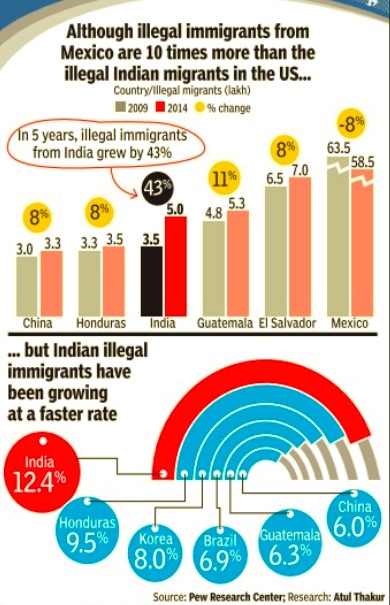
Nov 02 2016: The Times of India
See graphic:
Illegal immigrants in the USA, from India, Brazil, China and other countries, 2009-14
2013- 22
See graphic:
Indians driving unauthorised at American borders, 2013- 22
2013-15: 27,000 Indians detained in the USA
Another 45 Indians held in New Mexico, June 23, 2018: The Times of India
The Indian mission in the US has established contact with two immigration detention centres where nearly 100 Indians, mostly from Punjab, are detained for illegally entering the country through the south.
Around 40-45 Indians are at a federal detention centre in the southern US state of New Mexico while 52 Indians, mostly Sikhs and Christians, are held in Oregon. Most of the detainees at the federal facilities are asking for asylum claiming that they “experienced violence or persecution” in their home country.
Satnam Singh Chahal, of the North American Punjabi Association, believes thousands of Indians are languishing in US jails.
27,000 Indians detained during 2013-2015 in US
A consular official has visited the detention facility in Oregon and another one is scheduled to visit the detention facility in New Mexico. We are monitoring the situation,” the Indian Embassy said.
More than a dozen of them are being held at the New Mexico centre for months. And the rest of the Indians were brought to this detention centre about a week ago.
According to information obtained by NAPA through Freedom of Information Act (FOIA) between three years of 2013, 2014 and 2015, over 27,000 Indians were apprehended at the US border. Of these, over 4,000 were women and 350 were children. Many of them, it is reported, are still languishing in jails.
According to a FOIA request in 2015, more than 900 Indians were in various federal prisons on charges of illegally staying in the country.
Chahal alleged that there is a nexus of human traffickers, officials and politicians in Punjab, who encourage young Punjabis to leave their homes to illegally enter the US and charge Rs 35-50 lakh from each individual.
According to immigration attorney Akansha Kalra the largest number of Indians who enter the US illegally are from Punjab and Gujarat.
2018: 10k Indians detained in bid to remove illegal aliens
Nearly 10,000 Indians were detained in the US in 2018 by law enforcement agencies as part of their operations to identify and remove aliens who present a danger to national security or are a risk to public safety, according to a government report. Of these, 831 were removed from the US, the report said on Tuesday.
According to the report titled “Immigration Enforcement: Arrests, Detentions, and Removals, and Issues Related to Selected Populations” by government accountability office, the number of Indians detained by the US Immigration and Customs Enforcement (ICE) has more than doubled between 2015 and 2018.
In 2015, the ICE had detained 3,532 Indians, which increased to 3,913 in 2016; 5322 in 2017 and 9,811 in 2018. According to the report, the ICE removed 831 Indians in 2018. The figure was 296 in 2015; 387 in 2016 and 474 in 2017. The number of administrative arrests of Indians by the ICE in 2015 was 317, which increased to 390 in 2016, 536 in 2017, and 620 in 2018, the report said.
According to the report, the number of enforcement and removal operations by the ICE varied from calendar years 2015 through 2018 but increased overall from 1,12,870 in 2015 to 1,51,497 in 2018.
The ICE detention data also showed that detentions of transgender and pregnant individuals increased from calendar years 2016 to 2018 and detentions of individuals with disabilities increased from 2017 to 2018.
2019- 23
Ashish Chauhan, April 19, 2023: The Times of India
Ahmedabad : As many as 1. 49 lakh Indians were caught trying to unlawfully enter the US between February 2019 and March 2023, according to data from the US Customs and Border Protection (USCBP), revealing a grim truth that the “American dream” continues to lure Indian asylum-eekers despite several deaths in dangerous border crossings.
“Those detained are mostly from Gujarat and Punjab,” said a police officer from Gujarat. In January 2022, as many as 5,459 Indians were caught entering the US illegally. Of these, 708 were caught along the US-Canada border. The numbers rose 35. 9% to 7,421 in January 2023, including 2,478 detentions made on the US-Canada border.
Indians were detained in 2,663 attempted border crossings either from Canada in the north or Mexico in the south, the data says. Indians make up merely 2% of people detained for trying to enter the US illegally, but hardly a few were deported, according to Indian agencies and Gujarat police.
Many get refuge on humanitarian grounds. The US has been the world’s most popular destination for asylum-seekers since 2017, according to UN figures. Even those who lose in court canstay for years while their cases wind through a backlogged system.
Others were less fortunate. Gujarat police have been cracking down on organised human traffickers operating in the state after a family of four from Dinguchavillage, 44km from Ahmedabad, froze to death on the Canada-US border after they were reportedly separated in a blizzard from a larger group of Indians that made it across to the US in -35 degrees Celsius in January last year.
The tragic news left the country shaken, but did not stop Indians from attempting to make it to the US illegally — some ending in tragedies that underscored the desperation.
A Gujarati man fell to his death when he and his wife scaled the “Trump Wall” at the US-Mexico border on December 14 along with their three-year-old son. American border agents rescued the woman and the child.
In March this year, 9,648 Indian asylum-seekers were caught by US border guards — 2,289 of them on the USCanada border. The same month saw a family of four — Pravin Chaudhary (50), wife Daksha (45), and their daughter Vidhi (23) and son Mitkumar (20) — from Gujarat’s Mehsana drown when their boat capsized in the freezing waters of the St Lawrence river that flows along the border.
Through Canada: 2019-21
Ashish Chauhan, Oct 25, 2023: The Times of India
AHMEDABAD: The diplomatic ties between India and Canada got frosty in September, with the latter implicating the Indian government in the June killing of Khalistan leader Hardeep Singh Nijjar on their soil. But this diplomatic chill did little to deter the resolve of Gujaratis seeking to sneak into the United States through the Canadian border.
The numbers tell a compelling story: Data from the US Customs and Border Protection (USCBP), the largest federal law enforcement agency in the US, reveals that of the 8,076 Indians arrested for entering the US illegally through various routes, 3,059, or 38%, were caught on the US-Canada border.
This is also the highest number of such arrests in a month between October 2022 and September 2023.An inside source revealed, “Many Indian immigrants, primarily Gujaratis, had settled in Canada and eagerly awaited an opportunity to enter the US. In August 2023, 2,327 illegal immigrants were caught trying to smuggle into the US. This number rose to 3,059 in September.” These individuals included four unaccompanied children, four children accompanied by family members, and 530 who arrived with their entire families. The largest category comprised 2,521 single adults.
According to sources, illegal immigrants typically prefer to cross into the US through the Mexican border rather than the Canadian border. However, in September 2023, the number of illegal immigrants arrested at the US-Mexico border — 3,862 — was nearly identical to those reported by USCBP.
Between February 2019 and March 2023, a staggering 1.90 lakh Indians were arrested attempting to cross into the US unlawfully. The influx of illegal immigrants continues unabated, even though several families met tragic fates during their endeavours.
In January 2022, a family from Gandhinagar’s Dingucha village froze to death just 10m from the US-Canada border, while a family from Mehsana drowned in the St Lawrence River while attempting to enter the US illegally in April this year.
Despite efforts by the Gujarat police and Indian, US, and Canadian agencies to curb illegal immigration, the flow remains unstoppable, said a police officer.
2020-23
Ashish Chauhan, Nov 3, 2023: The Times of India
AHMEDABAD: A record 96,917 Indians were apprehended while unlawfully crossing into the US between October 2022 and September 2023, according to US Customs and Border Protection (UCBP) data.
The numbers have emerged despite the tragic loss of lives in recent years during such intrusions, particularly through hazardous routes. Of the 96,917 Indians, 30,010 were caught at the Canada border and 41,770 at the frontier with Mexico.
The rest are those tracked down mainly after sneaking in. The total marks a fivefold increase over 19,883 Indians caught in 2019-20.Law enforcement agencies point out that these figures represent only recorded cases, and the actual number is likely to be significantly higher. “This is just the tip of the iceberg. For every person caught at the border, there may be at least 10 others who successfully infiltrated the US,” said a police officer in Gujarat.
The state accounts for many of those taking the perilous route. “These are mainly people from Gujarat and Punjab who have aspirations to settle in America,” said an officer of Gujarat police probing illegal immigration rackets. Those arrested are classified under four categories — unaccompanied children, children accompanied by family members, and entire families. Single adults make up the largest category. This time, 84,000 single adults were apprehended at the US border. Alarmingly, 730 unaccompanied children were also detained.
One of the most egregious cases was of Brijkumar Yadav, a resident of Gandhinagar who attempted to cross into the US by scaling the Trump wall in December 2022. Tragically, he fell onto the Mexican side of Tijuana while holding his child and lost his life. His wife, Pooja, fell 30 feet onto the US side in San Diego. As a result, their three-year-old child was placed under the custody of Immigration and Customs Enforcement (ICE).
This case serves as a stark reminder of the potential presence of many Indian children in the US who find themselves in similarly perilous situations, a fact borne out by data.
The illegal influx is likely to have surged after the end of the pandemic-era border policy Title 42 in May, which allowed the US to swiftly deport illegal immigrants without asylum hearings. Despite the tragic incidents involving families attempting illegal entry, the flow of illegal immigration continues, despite efforts by the Gujarat police and Indian, US, and Canadian agencies to combat the issue. In various instances, including the Dingucha village tragedy and the Mehsana family’s drowning in the St. Lawrence River in April, individuals and families have been exposed to life-threatening risks in their pursuit of illegal entry into the US.
Sources in the central agencies and the Gujarat police said that though many Indians are caught in the US yearly, very few are deported as some obtain shelter there on humanitarian grounds.
2023-2024: 10 Indians per hour tried to enter US illegally
Ashish Chauhan, Oct 25, 2024: The Times of India
Ahmedabad : Despite the perilous journey and a series of deaths of illegal Indian immigrants trying to cross the border, the lure of a life in the US, especially among Gujaratis, remains strong.
During US FY 2024 — Oct 1, 2023 to Sept 30, 2024 — 29 lakh illegal immigrants were caught trying to enter the country through Mexico and Canada. Of these, Indians constituted 90,415, US Customs and Border Protection (US-CBP) data shows.
Of this total, roughly 50% were from Gujarat, sources in Indian agencies tracking illegal immigration said. It could also be said that 10 Indians were arrested every hour, the sources said. Also, 43,764 were arrested at the US bor- der with Canada, in the north, making it the highest number of Indians caught at this border till now.
The data reveals a slight decline from the previous year’s total of 32 lakh people, and in the number of Indians caught on the Mexico route. In FY 2023, the number of illegal In- dian immigrants caught was 96,917. In 2024, fewer Indians (25,616) were caught at the USMexico border; this number in US FY 2023 was 41,770.
“People have stopped using the donkey route via Mexico due to two key reasons. One is that they would be kept in Dubai or Turkey for some time before being taken to Mexico. US agencies, over the past few years, have been keeping sharp vigil on illegal immigrants staying in those countries and have broken links in the human smuggling chain,” a source in the immigration network said.
A source said, “Gujaratis, too, began choosing Canada over Mexico as they could easily hire a taxi and cross over to the US. Recently, US authorities have tightened vigil on this border. Such immigrants are usually sent to Canada as most of them carry a Canadian visitor visa. However, the immigrants try again after some time on the same route.”
Sources also said that people caught at the border may be very few compared to those who actually manage to sneak into the US.
Number of illegal Indian immigrants vis-à-vis other source countries, As of 2024

From: Dec 25, 2024: The Times of India
See graphic:
Number of illegal Indian immigrants vis-à-vis other source countries, As of 2024
Deportation of illegal Indian immigrants
2019- 2024
Ashish Chauhan, Dec 27, 2024: The Times of India

From: Ashish Chauhan, Dec 27, 2024: The Times of India
Ahmedabad : This year, one Indian was deported every six hours from the US, according to the US Immigration and Customs Enforcement (ICE) Fiscal Year 2024 Annual Report released on Dec 19.
The number of Indians deported has grown by 400% between 2021 (292 out of total 59,011 deported) and 2024 (1,529 out of 2,71,484).
A senior officer of an Indian central agency said, “The fluctuations in removal numbers over the years can be attributed to various factors, including changes in US immigration policies, en- forcement priorities, and bilateral agreements between the US and India. The increase in 2024 may also reflect broader migration trends and enforcement actions targeting individuals without legal status in the US.”
During the Covid years of 2019 and 2020, under Donald Trump’s first term as US president, a total of 3,928 (1,616 and 2,312, respectively) illegal Indian immigrants were sent back. Comparatively, in 2021 when Joe Biden took office as US president, the total number of Indians deported till the report’s release in 2024 had reached 3,467.
ICE has already drawn up a list of individuals slated for deportation, and nearly 18,000 undocumented Indians find themselves facing the prospect of being sent back home. ICE data until Nov 2024 shows that 17,940 Indians are among the 14.4 lakh individuals on the non-detained docket with final orders of removal from the US.
2009- 2024/25 Feb
Sachin Parashar, February 7, 2025: The Times of India

From: Sachin Parashar, February 7, 2025: The Times of India
New Delhi : US authorities doubled down on the deportation of 104 Indian nationals with the border patrol chief releasing a video that showed Indian nationals, handcuffed and shackled, being hustled into a C-17 military aircraft.
Asked why a military aircraft was used to deport Indians, a US embassy spokesperson, without going into details of the flight, said it was the policy of US to faithfully execute the immigration laws against all inadmissible and removable aliens. In the first two weeks of President Trump’s return, while dozens of nonmilitary flights were used to deport illegal migrants, only six such military flights — to Honduras, Ecuador, Peru and Guatemala — were used for the same purpose.
“The US Border Patrol and partners successfully returned illegal aliens to India, marking the farthest deportation flight yet using military transport. This mission underscored our commitment to enforcing immigration laws and ensuring swift removals. If you cross illegally, you will be removed,” USBP chief Michael Banks said in a post on X. The embassy spokesperson here also said enforcing US immigration laws was critically important to national security and public safety of the country.
While foreign minister S Jaishankar said in response to clarifications sought in Parliament that India was aware about the flight that landed in Amritsar and had provided it necessary clearances, a few central and South American countries have complained that they were notified about deportation flights only after takeoff. Brazil also lodged a protest with US for the “flagrant” violation of the rights of its citizens.
India has accepted illegal immigrants from US every year since 2009 after verifying their Indian origin. Modi govt accepted more than 6,000 nationals from the US during the first Trump administra- tion. However, the in-yourface spectacle that accompanied what was the first deportation flight to India under Trump 2.0 will be of concern to India, not least because it occurred days before PM Modi lands in Washington for a bilateral summit with Trump.
Indian languages spoken in the US
2010- 17: growth of linguistic groups
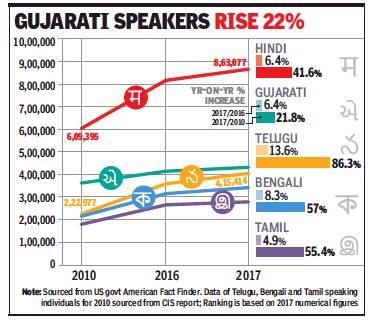
From: Lubna Kably, Hindi most spoken Indian language in US, Telugu speakers up 86% in 8 years, September 21, 2018: The Times of India
Hindi continues to be the most widely spoken Indian language in the US, followed by Gujarati and Telugu. However, in terms of percentage increase, if the data of 2010 is compared with the most recent figures for 2017, the number of Telugu speaking individuals has risen the most — by 86%.
American Community Survey (ACS) data, recently released by the US Census Bureau for 2017 — it measures the US population as of July 1, 2017 — shows that nearly
21.8% of residents in US aged over five (including nativeborn, legal and illegal immigrants) spoke a language other than English at home.
Of the total populace of 30.5 crore, 6.7 crore spoke a foreign language at home. In FY 2016, with 6.5 crore out of a total populace of 30.3 crore speaking a foreign language at home, the percentage was slightly lower at 20.6%.
Hindi had 8.63 lakh speakers in the US, followed by Gujarati (4.34 lakh) and Telugu (4.15 lakh).
Foreign language speakers in US has doubled since 1990: CIS
The Center for Immigration Studies (CIS), which is viewed as an anti-immigration thinktank, has analysed this data, specifically comparing the statistics of 2017 with 2010. As per its report, over a seven-year period from 2010, the number of Telugu speakers has risen exponentially by 86%. The corresponding rise as regards Hindi and Gujarati speakers was just 42% and 22% respectively.
TOI in its edition dated September 17, had reported that 26.10 lakh of the US population were born in India (this figure did not include those having Indian parents but born in the US). In the backdrop of this statistic, at least 33% of the Indians in the US speak Hindi, nearly 17% speak Gujarati and Telugu.
CIS reports that the total figure of those who speak a foreign language has more than doubled since 1990 and almost tripled since 1980. According to CIS, in America’s five largest cities, 48% of the residents speak a language other than English at home. For instance, in Los Angeles it is 59%, in New York and Houston it stands at 49%.
TOI for the purpose of its analysis has primarily relied on the data available on the US Census Bureau-American Fact Finder website. However, for 2010, this website did not show some Indian languages, which didn’t then have a large speaking populace — like Telugu, Bengali and Tamil but clubbed them as ‘other Indic languages’. For this breakup, TOI has relied on the CIS report.
2017> 18
Lubna Kably , Oct 31, 2019: The Times of India
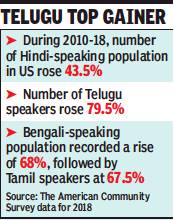
From: Lubna Kably , Oct 31, 2019: The Times of India
Hindi continues to be the most widely spoken Indian language in the US, followed by Gujarati and Telugu.
In terms of absolute numbers, Hindi was the most widely spoken Indian language in the US with 8.7 lakh speakers as of July 1, 2018, reflecting a slight increase of 1.3% over the 2017 figures. Over an eight-year period, since 2010, the numbers have increased by 2.7 lakh, a rise of 43.5%.
However, in terms of percentage increase, the number of Telugu-speaking individuals far outstripped speakers of other Indian languages in the US, rising 79.5% between 2010 and 2018.
The American Community Survey (ACS) data for 2018 (it measures the US population as of July 1, 2018), recently released by the US Census Bureau shows that 67.3 million residents in the US, aged over five (which includes native-born, legal and illegal immigrants) speak a language other than English at home.
Almost 22% of US residents speak a foreign tongue at home
As a share of population, almost 22% of US residents speak a foreign language at home — the percentage is only a tad higher than the 21.8% reflected in the data of 2017. The American Community Survey (ACS) survey is the largest undertaken by the US government each year and covers over 2 million households.
The Bengali-speaking USbased population at 3.75 lakh has shown a rise by nearly 68% over the same eight-year period. This is followed by those who speak Tamil, showing a rise by 67.5% to stand at 3.08 lakh as of July 1, 2018.
However, it should be noted that individuals from countries other than India also speak Bengali (predominately Bangladesh). Immigration experts say the spike in the Bengalispeaking population may also be representative of a larger inflow to the US from Bangladesh.
The numbers of those speaking Gujarati and Telugu has dipped between 2017 and 2018. Those speaking Gujarati stood at 4.19 lakh, a decline of 3.5% over the previous year. And there were 4 lakh Telugu speakers as of July 1, 2018, as against a higher figure of 4.15 lakh in the previous year (a decline of 3.7%). If figures of 2010 are compared with those of 2018, the number of Telugu speakers increased from 2.23 lakh to 4 lakh, a rise of 79.5%. This is not surprising as a fair share of technology sector staffers, are said to hail from Andhra Pradesh and Telangana.
The US Census Board does not provide a linguistic cum country-wise breakup. As a dominant percentage of Urdu and Punjabi speaking populace in the US is anecdotally said to hail primarily from Pakistan, TOI has ignored these statistics in its analysis. The Center for Immigration Studies (CIS), a US-based think-tank, has released a report, based on the census data. According to the CIS, the number of those speaking a language other than English at home, has more than doubled since 1990 and almost tripled since 1980.
Language-wise
Telugu states
2016-2023
Amisha Rajani, June 27, 2024: The Times of India

From: Amisha Rajani, June 27, 2024: The Times of India
Hyderabad : Telugu students packing their bags for the US this fall are more likely to feel at home than before. There has been an explosion in the Telugu-speaking population across America, from 3.2 lakh in 2016 to 12.3 lakh in 2024.
According to a Statistical Atlas of the US report based on US Census Bureau data this population ranges from fourth-generation immigrants to recently-arrived students. California hosts the largest Telugu-speaking population — of close to 2 lakh – closely followed by Texas (1.5 lakh) and New Jersey (1.1 lakh). States like Illinois (83,000), Virginia (78,000), and Georgia (52,000) too have a significant pool of people from the two Telugu states. Data shows each of these states have seen an almost four-fold rise in numbers. Local Telugu associations say these numbers are in line with their own estimates.
Out of 350, Telugu is now America’s 11th most-spoken language
Between 60,000 and 70,000 students arrive in the US each year, along with close to 10,000 H1B v isa holders. About 80% of them are registered with us,said Ashok Kolla, former secretary of the Telugu Association of North America. “Over 75% of them settle here in the US, mostly in Dallas, the Bay Area, North Carolina, New Jersey, Atlanta, Florida, and Nashville.” The older generations are largely entrepreneurs, whereas over 80% of the younger lot are in IT and finance. Telugu influence has seen such a rise that it is n ow the 11th most spoken foreign language — out of 350 languages — in the US, and the third most spoken Indian language, preceded by Hindi and Gujarati.
“When I moved to Dallas last year, I felt right at home,” said Vi nay K, who moved to Texas for a data analyst’s job. “From my PG to my office, from streets to malls, I was surrounded by Telugus. Most of my colleagues from India are from AP and Telangana, which helped me settle down and not feel homesick,” the young professional said.
Old-timers recount how communities around them have seen a shift in the ethnic composition over the years. “I don’t remember knowing more than four or five Telugu families when I first moved. But over the years the community has grown significantly. It’s like we have a third state after AP and Telangana in the US. There are more footfalls in temples and community spaces now,” said T Raghavendra Rao, a 63-yearold businessman who’s lived in NJ for over five decades. According to the Indian Mobility Report 2024, AP and Telangana form the largest cohort of Indian students in the US — accounting for 12.5% of the total student crowd. So much so that Kent State University has started receiving their new batches with signs that read “Vidhyardhulaku Swagatham (Welcome Students)”. “I was moved by this gesture,” said Indra Varsini, pursuing a master’s in IT in NJ. “I feel I am not too far from my own people,” she added.
Muslim Indians
2022
Lubna Kably, June 6, 2023: The Times of India
Mumbai: India-born people again cornered the lion’s share of H-1B applications approved by the US Citizenship and Immigration Services in the fiscal year 2022 (year ending September 30, 2022), getting 3.2 lakh, or 72.6%, of the total 4.4 lakh such visas granted.
This means, nearly three of every four H-1B visas granted went to India-born persons. The second most common country of birth was China, with a comparatively meagre number of 55,038 (12.5% of the total). Canada with 4,235 successful applicants (1%), stood third in ranking. The numbers include approval of H-1B visas for initial employment and also for continued employment (visa extensions).
H-1B visas can be allotted for a maximum of six years. If the beneficiary (individual who is sponsored by the American employer) is on track for a green card, periodical extensions are permitted.
National Geographic Bee
PIOs dominate, 2010, 2012-16
The Times of India, May 27 2016
PIOs sweep National Geographic Bee contest
Rishi Nair, 12year-old Indian-American student, has won the $50,000 National Geographic Bee competition in which Indianorigin contestants maintained their dominance by sweeping all the top three slots.
Seven of the 10 finalists were Indian-Americans.
As National Geographic Bee champion in the 28th edition of the contest, Nair, a sixth grader from Florida, received a $50,000 college scholarship and a lifetime membership in the National Geographic Society. This is the fifth consecutive year that an Indian-American has won the prestigious national tournament. In 2015, Karan Menon had won the competition.
Eighth-grader Saketh Jonnalagadda, 14, from Massachusetts was the runner up and recipient of the $25,000 college scholarship. Third place and a $10,000 college scholarship was grabbed by Kapil Nathan, 12, a sixth-grader from Alabama. The final question, which clinched the win for Nair, was: “A new marine sanctuary will protect sharks and other wildlife around Isla Wolf in which archipelago in the Pacific Ocean?“.
The answer was: “Galapagos Islands“. Nair, whose parents hail from Kerala, is the second Florida student to win the contest. In 2010, eighthgrader Aadith Moorthy of Palm Harbor was the national champion. The contest ended with a nail-biting final round between Nair and Saketh.
Philanthropy (giving back—to the USA)
2000-18: PIOs donated $1.2bn to their US alma maters
Indian-origin alumni have given more than $1.2 billion to American institutions of higher education since 2000, a new survey has revealed. The most prevalent recipient fields of donations were business (23.5%) and medicine (20.6%), closely followed by South Asia Studies
(17.6%) and engineering and computer sciences (13.3%), according to a monitor of university-giving compiled by Indiaspora, an organisation that seeks to transform the success of Indian Americans into meaningful impact in India and on the global stage.
Even the $1.2 billion recorded by Indiaspora may be an under-reported figure because the database compiled by the organisation counted donations of only $1 million and above and did not take into said account anonymous donations, said M R Rangaswami, a Silicon Valley entrepreneur and founder of Indiaspora.
In all, Indiaspora’s Monitor of University Giving — a “living database” to keep abreast of Indian-American philanthropic donations to higher education — counted fifty individuals making 68 donations of $1 million dollars or more amounting to over $1.2 billion. Of these donors, nearly half are repeat donors indicating how passionately Indian Americans feel towards giving back to American institutions of higher education, in many but not all cases, their alma maters, the organisation said.
“Indian Americans are acutely aware of the vital role played by American Institutions of Higher Education in their professional success stories, and many of us consider it a moral obligation to give back and pay it forward for the next generation of Americans,” Rangaswami told TOI on Monday while announcing the formation of the live database.
Indian-Americans are by far the best-educated and highest-earning ethnic group in the US with a median family income of more than $ 100,000 per annum (compared to a national figure of around $ 60,000). About 32% of Indian Americans have Bachelor’s Degrees compared to 18% for Americans and 38% of Indian Americans have Advanced Degrees compared to 10% of Americans with advanced degrees.
Among the biggest donors to US institutions are the Florida couple Pallavi and Kiran Patel who have contributed tens of millions of dollars to the University of Southern Florida and Nova Southeastern University. A cardiologist and businessman, Kiran Patel’s contributions include $50 million in a cash donation to the medical school at NSU and $150 million in real estate, accounting for what is believed to be the single largest philanthropic contribution by a PIO in the US.
While seven of the 68 donors (Sumir Chadha, Desh Deshpande, Kris Gopalkrishnan, Raj Gupta, Deepak Raj, Anand Rajaraman, and Sanjay Swani) recorded in the Indiaspora database are members of the organisation, the list also includes India-residing alumni of U S institutions such as Anand Mahindra (Harvard) and Ratan Tata (Cornell). According to Rangaswami, there is a gradual shift in Indian-American giving, acts of philanthropy moving from religious donation to giving for education.
Fifty individuals made 68 donations of $1 million dollars or more amounting to over $1.2bn, according to data compiled by Indiaspora, an organisation that seeks to transform the success of Indian-Americans into meaningful impact in India & on the global stage
The number of Indians in the USA
2008-2017: dwindling annual migration

From: Rachel Chitra and Ranjani Ayyar, Tightening US citizenship regime hits ‘American dream’ of desis, March 27, 2018: The Times of India
Indians will need more patience if they want to achieve the grand “American dream” — as data shows the US government is not granting citizenships at the pace it was doing a decade ago. In the last 30 years, the US was at its most liberal in 2008, when it granted as many as 65,971 citizenships; a reflection of the influx of Indian highly skilled immigrant workers arriving on US shores at the rate of 120,000 workers a year between 1995-2000.
While 2017 citizenship numbers (49,601) are an improvement from 2014 when it hit a decade-low (37,854) — the overall trend is still dampening as the number of immigrants have dropped to 1.51 million from 1.72 million during the same period. “The H-1B matter was a wake up call. Now companies are adopting a cautious approach given the changing policies. US companies do not require Indian techies as much as they needed earlier,” said Paul Dupius, CEO, Randstad India, a HR and staffing firm.
Since the 1990s Indians have been the second or third largest immigrant population to be granted citizenship after Chinese and Mexicans. Most Indians take the highly skilled work visa-green cardcitizenship route. But with immigration numbers on a decline the need for a fresh influx of Indian engineers, MBAs and doctors is waning as more US corporates looking to hiring locals.
“More Indians started coming to the use, when US immigration policy started favouring skill-based immigration to one based on family-connections. The average time it takes to process a green card has gone up from a couple of years to as much as 7-8. Indians have made more applications than any other country in the world – which means they have a longer waiting period,” said Mark Davies, an immigration lawyer.
Given that the biggest gateway to entering the US has been IT companies, the Trump administration’s recent policies are pushing US corporates to scale back recruitment of foreign workers.
2010-17: growth in India-origin population

From: One in 7 US residents foreign-born, India tops with 8.3L migrants in 7 yrs, September 17, 2017: The Times of India
Statistics released by the US Census Board last week show that immigrants (both legal and illegal) comprised nearly 14% of the US population. In other words, one out of seven US residents is foreign born.
In terms of numbers, the foreign-born population, based on findings of the American Community Survey (2017), rose by almost 8 lakh in 2016 to stand at 44.5 million (or 4.45 crore) in July 2017, which is an increase of 1.8%. America is touted as a land of immigrants, but this share of immigrants in the total population is the highest in over a century. The Center for Immigration Studies (CIS), which is viewed an anti-immigration think-tank, terms this as a record increase. “As recently as 1980, just one out of 16 US residents was foreign born,” CIS points out in its report.
CIS has done an extensive analysis of the data. According to its report, the ‘sending’ countries with the largest numerical increase in immigrants between 2010 and 2017 were India (up by 8.30 lakh), China (up by 6.77 lakh) and the Dominican Republic (up by 2.83 lakh). The percentage increases for these countries between 2010 and 2017 were 47%, 31% and 32% (see table).
Nepal showed the highest percentage increase in immigrants since 2010. With 1.52 lakh Nepalese in US, as of July 2017, it showed a percentage increase of 120% since 2010. Pakistan showed a percentage increase of 31% in terms of inflow of migrants to US to stand at nearly 4 lakh in number.
According to the US Census Board, the term foreignborn, refers to individuals who were not US citizens at birth. It includes those immigrants who later obtained US citizenship, green card holders, temporary workers (such as those on H-1B visa) and international students.
The report by CIS points out that between 2010 and 2017, 95 lakh new immigrants settled in the US. New arrivals are offset by roughly 3 lakh immigrants who return home each year and an annual natural mortality of an equal number. As a result, the immigrant population grew 46 lakh from 2010 to 2017.
Recent protectionist measures may, in the coming years, result in a gradual decline in the number of foreign-born in the US, owing to a number of factors, such as increase in denial of work visas or extensions to temporary workers, slowdown in hiring of immigrants, dip in the number of international students and deportation of illegal immigrants.
2010-18
Nov 20, 2019: The Times of India
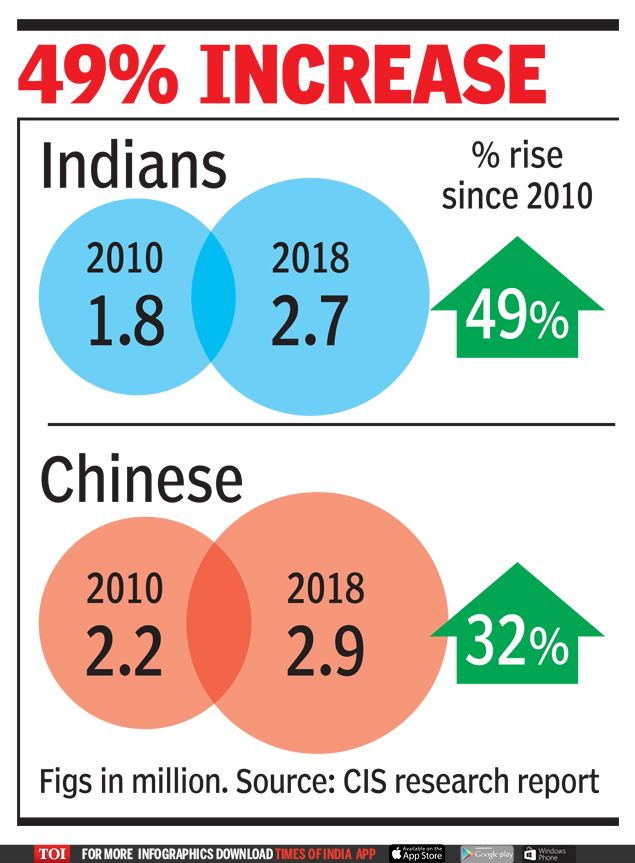
From: Nov 20, 2019: The Times of India
Key Highlights
The total number of foreign-born population in the US stood at 44.7 million or 13.7% of the total US population of 327 million till July 1, 2018: Official data
The rise in the number of foreign-born over the previous year is insignificant with a mere 0.4% increase
MUMBAI: The United States of America continues to be a land of immigrants, but there is a significant decline in the number of new migrants.
According to the American Community Survey (ACS) data for 2018, which measures the US population as of July 1, 2018, the total number of foreign-born population in the US stood at 44.7 million or 13.7% of the total US population of 327 million.
The rise in the number of foreign-born over the previous year is insignificant with a mere 0.4% increase. However, compared with 2010, where the total number of foreign-born population stood at 40 million, it signifies an increase of 11.8%.
The Center for Immigration Studies (CIS), a US based think-tank, which is considered to be protectionist in its views, has in its research report, provided data based on country of birth.
As of July 1, 2018, the population originating from India stood at 2.65 million, a miniscule increase of 1.5% over the previous year’s figure of 2.61 million.
Indians constituted 5.9% of the total foreign-born population as of July 2018, but comprise less than 1% of the total US population. Between 2010 and 2018, the number of those from India rose by 8.7 lakh, signifying an increase of 49%. Back in 1990, there were just 4.5 lakh individuals having their place of birth in India. The number increased by 489% from this date till 2018.
The foreign-born population from China increased from 2.16 million in 2010 to 2.84 million in 2018 (up by 6.78 lakh) signifying an increase of nearly 32%.
According to the US Census Board, the term foreign-born refers to individuals who were not US citizens at birth. It includes those immigrants who later obtained US citizenship, green card holders, temporary workers (such as those on H-1B visa) and international students. It does not include those who are on a short stay such as tourists and business travellers.
CIS in its research paper states that 1.45 million new legal and illegal immigrants settled in US in 2017, fewer than the 1.75 million in 2016 or 1.62 million in 2015. “The falloff in arrivals in 2017, may be due to increased enforcement efforts, lower refugee admissions and more robust vetting of applications undertaken by the Trump administration,” it states in its research report. It points out that full data is available of immigrants in 2017, but as the population is captured as of July 1, only data of the first six months is available for 2018.
2017: 21,000 Indians overstayed their visas
August 9, 2018: The Times of India
Over 21,000 Indians who were supposed to leave the US at the end of their permissible limits last year overstayed their visas, the department of homeland security (DHS) said on Wednesday.
While the percentage of Indians overstaying and not leaving the US after the expiry of their visas is not very high compared to some other nations, but India ranks among the top 10 countries whose citizens come to the US legally and continue to stay illegally.
DHS in its latest annual report said 7,01,900 foreigners who entered the country through an air or sea Port of Entry overstayed their visas between October 2016 and September 2017. It said in 2017, more than 10.7 lakh Indians visited the US on the B-1, B-2 visas, which is issued to those who come to the US for business, visit or tourism purposes.
Of these, 14,204 overstayed in the country. According to the report, 1,708 of these Indians left the US later after the expiry of their visas, while there is no record of 12,498 Indians leaving the country. This could be presumed that they continue to stay in the US as an illegal immigrant.
In 2017, the report said, 1,27,435 Indian students and research scholars came to the US. Of these 4,400 Indians overstayed in the country. Figures indicated that 2,833 Indians are still in US. Among other categories of non-immigrants, more than 4 lakh Indians were expected to leave the US in 2017, of which 9,568 of them overstayed. Among them, 6,612 are suspected to be illegally staying in US. PTI
2018, Jan- Sept: No. of Indian illegals held up 300%
No. of Indian illegals held in US up 3 times, September 30, 2018: The Times of India
The number of Indians arrested for illegally entering the US has nearly tripled to around 9,000 so far in 2018, making them one of the largest groups of illegal people apprehended, US Customs and Border Protection said on Friday.
Paying smuggling rings between $25,000-$50,000 per person, a growing number of Indians are illegally crossing the US-Mexico border and claiming asylum for persecution, CBP spokesman Salvador Zamora said. Many present viable claims, but a large number are economic migrants with fraudulent petitions that swamp the system and can cause legitimate cases to be “washed out” in the high volume of fraud, he said. REUTERS
US denied 42% of Indian asylum pleas between FY12 and FY17
Around 4,000 Indians who entered the US illegally this year did so over a three-mile stretch of border fence at Mexicali, Zamora said. “The word got out that Mexicali is a safe border city which favors their crossing into the US,” he said, adding that the CBP expects the data for the fiscal year ending September 30 would show “around 9,000” Indian nationals had been apprehended versus 3,162 in fiscal year 2017.
However, Indians still have some way to go to outnumber the roughly 30,000 El Salvadorans who entered the US illegally in 2018, the data showed.
Asylum seekers range from lower caste “untouchable” Indians facing death threats for marrying outside their class to Sikhs claiming political persecution, immigration lawyers said. Fraudulent asylum seekers often present “cut and paste” evidence identical to that of other migrants, Zamora said.
Some 42.2% of Indian asylum cases were denied between fiscal years 2012 to 2017, according to Syracuse University’s Transactional Records Access Clearinghouse. The Indian embassy in Washington and the Indian consulate in San Francisco did not respond to requests for comment. After being held in the US, Indians are often bonded out of detention by human trafficking rings, Zamora said. They then enter indentured servitude in businesses ranging from hotels to convenience stores to pay off smuggling debts and bond fees, Zamora said.
Sikhs
Sikh family in US gets death threat
[ From the archives of the Times of India] circa 2008
A Sikh family in America received an anonymous letter that threatens to kill its members for being “associates of the Taliban”, prompting authorities to launch a probe into it.
The letter, addressed to the ‘Turban Family’, said the family is being closely watched and it should leave the US immediately.
“Our people in the neighborhood have been closely watching your activities and figured out you are a close associate of a secret Taliban movement on the US Soil. We ask you to leave the country as soon as possible otherwise one of our people is going to shoot you dead. Don’t attempt to relocate elsewhere in America as people are closely monitoring your day to day activities,” the letter said.
The identity of the family, which lives near Virginia, has not been released. Local authorities are working with the FBI to investigate the threats in the letter sent to the family last week.
The Sikh American Legal Defence and Education Fund said the family had previously been the target of similar hate crimes. PTI
Targetted by racists
2018: Sikhs 3rd most targeted group in US: FBI
Nov 14, 2019: The Times of India
Around 60 incidents of hate crimes against Sikhs were reported to the FBI in 2018, making the community the third most commonly targeted religious group after Jews and Muslims in the US, according to an annual report released by the bureau.
A total of 7,120 hate crimes were reported by law enforcement agencies around the country last year, slightly down from 7,175 in 2017, the FBI said, adding that this involved 8,496 offences.
The largest number of hate crimes based on religion were reported against Jews (835), followed by Muslims (188) and Sikhs (60). As many as 91 hate crimes were reported against other religions, including 12 against Hindus and ten anti-Buddhist crimes. PTI
2021: Sikhs 2nd most targeted group
IP Singh, February 23, 2023: The Times of India
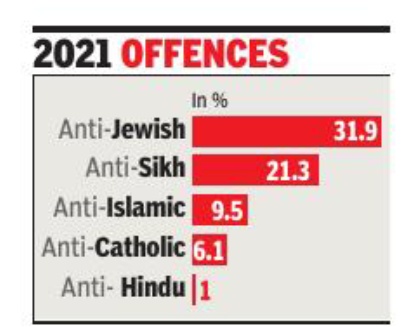
From: IP Singh, February 23, 2023: The Times of India
Jalandhar : Sikhs were the second most targeted religious group after Jews in hate-motivated crimes in the US in 2021, an FBI report said recently, while Hindus and Muslims made up 1% and 9. 5% of the 1,005 offences recorded that year.
There were 214 (21. 3%) hate crimes against Sikhs and 10 against Hindus, according to FBI’s annual data. Anti-Semitic crimes were the highest at 31. 9%, while the count for Catholics was 6. 1%.
Among the crimes was the shooting by a former employee at a FedEx facility in Indianapolis on April 16, 2021. Eight people were shot,including four Sikhs working in the warehouse.
Sikhs who first began arriving in the US in the late 1800s are a small religious minority. American Sikhs have in the past been targeted in racist attacks, which escalated after the 9/11 terrorist strike in 2001.
Entrepreneur Balbir Singh Sodhi was killed at his Arizona gas station four days after the September 11 attacks by a man who declared he was “going to go out and shoot some towelheads” and mistook him for an Arab Muslim. On August 5, 2012, a white supremacist shot six Sikhs and injured four at a gurdwara in Oak Creek, Wisconsin. This was the biggest attack against the community in America, prompting calls tohave safety plans in place in about 300 gurdwaras across the country and to raise awareness and understanding about their religion.
FBI hadn’t tracked hate crimes specifically against Sikhs until 2015, according to a report, and many local law enforcement agencies fail to record bias attacks comprehensively.
The FBI data for 2021, when the US was ravaged by the pandemic like much of the world, shows 64. 8% of hate crime victims were targeted for their race, ethnicity, and ancestry. Crimes against African Americans topped at 63. 2% in 2021, while 4. 3% anti-Asian offences were reported.
To be counted as separate ethnic group in ’20 census
January 16, 2020: The Times of India
WASHINGTON: For the first time, Sikhs in the US will be counted as a separate ethnic group in the 2020 census, an organisation of the minority community said on Tuesday, describing it as a milestone moment.
President of the Sikh Society of San Diego Baljeet Singh said the Sikh community's efforts have come to fruition.
"This has paved the way forward nationally not only for the Sikh community but also for other ethnicities in the United States," he said.
Describing this as a milestone, the United Sikhs said that this will be the first time the minority group will be counted and coded in the decennial US Census.
A delegation of the United Sikhs has held several meetings with the US Census in the recent past with the last one being on January 6 in San Diego.
"It's clear that a separate code is needed to ensure an accurate count of Sikhs in the United States, recognising a unique identity," said US Census Deputy Director Ron Jarmin.
"Working with United Sikhs, we understand how this change affects the national Sikh community, leading us to add this code for the 2020 Census," said Shagufta Ahmed with the Census Bureau and Office of Management Budget.
According to the United Sikhs, the current estimates of Sikhs living in the US are at 10 lakhs.
Sikhs meet the criteria for representation in the US Census as a distinct ethnic group and have a distinct unified appearance, culture, language, food and history.
The United Sikhs has advocated for the separate coding for more than two decades and filed commentary with the US Federal Register advocating for Sikhs to be added as an ethnic group, in large part, so that action can be taken to address major Sikh issues such as bullying, intimidation and hate crimes against the community.
"With the 2020 census approaching, many historically undercoded communities will be at-risk for being under-counted and under-served," said Ruben Singh, United Sikhs Census Manager.
"We look forward to collaborating with our census partners and other Sikh organisations and institutions to address the unanticipated challenges of the 2020 Census," he said.
Meanwhile, the Sikh Coalition has partnered with the Census Bureau for the 2020 census.
This is because Sikhs have traditionally been a 'hard to count' population in the United States, said Satjeet Kaur, Sikh Coalition executive director.
"Our community matters, and we want to make sure that Sikh families are appropriately counted and accurately resourced wherever they are across our country," she said.
Statistics (general)
1965-2018: an overview

From: October 13, 2018: The Times of India
See graphic:
Indian (and other) immigrants in the USA. 1965-2018: an overview
Students (from India) in the USA
See Indian students in the USA
Top Indian-Americans
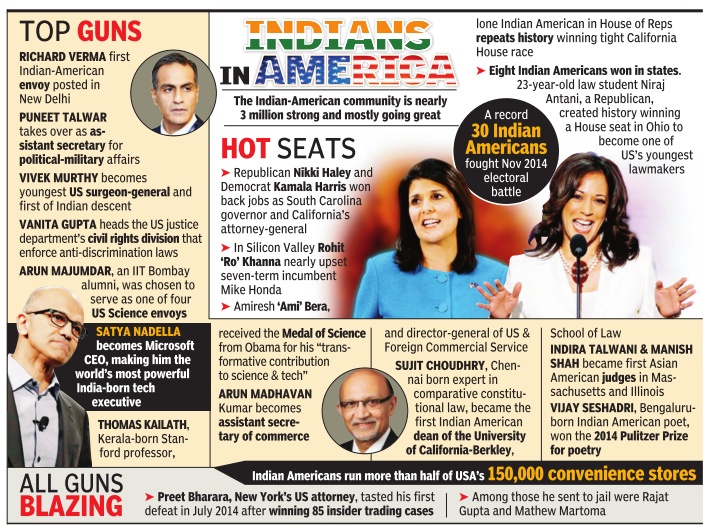
See graphic:
Top Indian Americans
Trucking
2025: PIOs own 20% of US trucking firms
[ The Times of India]
The major influx of Sikhs to the US began in the 1980s and 1990s, with many fleeing anti-Sikh violence in India following PM Indira Gandhi’s assassination. Trucking emerged as an accessible entry point for these immigrants, many of whom arrived in the US with limited English proficiency and no formal education. With annual salaries often ranging from $50,000 to $100,000, without requiring advanced degrees or language fluency, long-haul truck driving became the go-to for many Sikh immigrants. The independent nature of the job allows adherents to fully comply with the Sikh Articles of Faith, such as maintaining uncut hair, wearing a turban, and carrying a ceremonial dagger — practices often restricted in other work environments due to safety codes. Sikh drivers have now become an indispensable component of the nation’s supply chain, filling a chronic US driver shortage projected to hit 174,000 by 2026. The community created a self-sustaining ecosystem: early drivers mentored newcomers, leading to the formation of family businesses, truck stops, and advocacy groups like the North American Punjabi Trucking Association (NAPTA). Sikhs own an estimated 20% of US trucking firms.
The Sikh workforce, comprising about 150,000 people (with 135,000 drivers) in the industry, represents roughly 4% of the US total driver pool, including 40% of West Coast drivers. NAFTA even has a weekly news show, Punjabi Trucking 360, designed specifically for its truckers. Following the accidents and the resulting media coverage, the broader Punjabi trucking community is reporting harassment and fears of being unfairly targeted.The actions of two men, particularly those involving allegations of DUI, vehicular manslaughter, and immigration fraud, have amplified MAGA rhetoric questioning the integrity of the entire immigrant driver workforce.
History
Chandrima Banerjee, February 7, 2025: The Times of India

From: Chandrima Banerjee, February 7, 2025: The Times of India
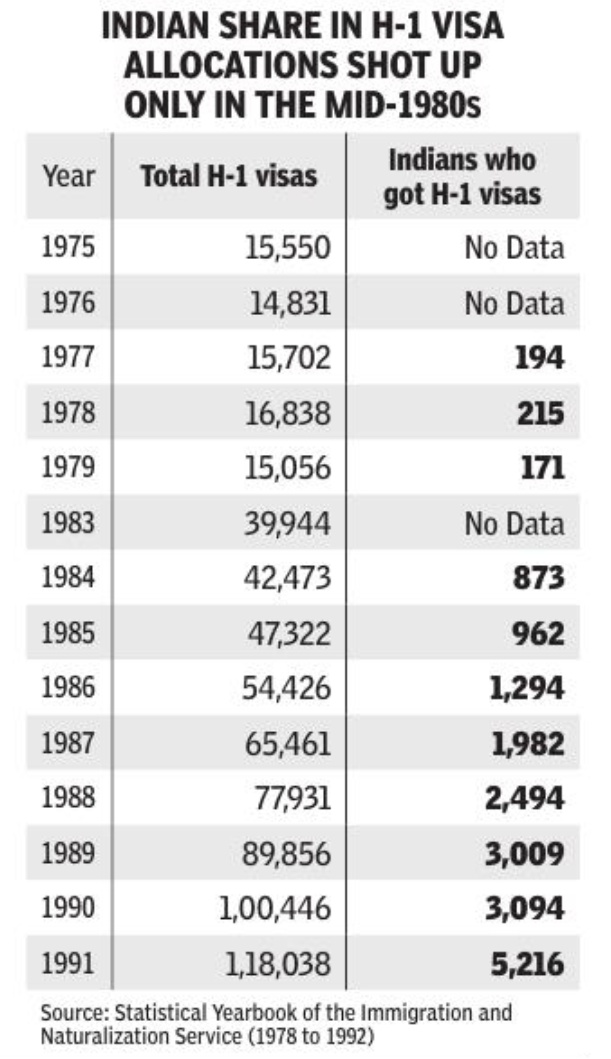
From: Chandrima Banerjee, February 7, 2025: The Times of India
➤ US moved away from the system of entry based on race after World War II. With the Immigration and Nationality Act of 1952, US Congress introduced the preference for skilled workers. H-1 was for workers of “distinguished merit and ability” who would perform “temporary services of an exceptional nature” but with deep roots in “a foreign country which he has no intention of abandoning”.
➤ For Indians, though, that didn’t change much. Their entry was banned between 1917 and 1924, and restrictions were in place till 1946, when Indians were allowed into the country but with an annual quota of 100. That quota was left unchanged by the 1952 law.
H-1 Didn’t Click For Indians, Story Changed With H-1B
➤ In 1965, national quotas were removed in favour of special skills and family reunification. A steady flow of Indian professionals into the US finally began — primarily engineers, doctors, scientists, educationists. But most H-1 visas were still going to people from Canada, Europe and to countries like Philippines and Japan. By mid-1980s, H-1 visa numbers for Indians began to be on a par with those for Germany, Ireland. Then, too, there had been cries that H-1 was being used “by aliens as a means of becoming immigrants”.
➤ The Immigration Act of 1990 created the H-1B visa for skilled, temporary workers and introduced an annual cap of 65,000 for this category. The changes took effect in 1991, the year of liberalisation of India’s economy. It was also a time when the US tech industry began to pick up even as fewer white people began to enrol in science and engineering courses. Indians quickly moved in to fill the gap.

H-1B acceptance, company-wise, 2016> 17;
The main US states to which Indians with H-1B visas went to work in 2016- 17;
Working spouses of Indians with H-1B visas: 2015> 17
From: October 19, 2018: The Times of India
See graphic:
2007-18: Share of Indians in H-1B applications;
H-1B acceptance, company-wise, 2016> 17;
The main US states to which Indians with H-1B visas went to work in 2016- 17;
Working spouses of Indians with H-1B visas: 2015> 17
2018: 74% of H-1B visa holders were Indians
‘Three-fourths of H-1B visa holders in 2018 are desis’, October 21, 2018: The Times of India
Nearly three out of every four H-1B visa holders as of October 5 are Indian citizens, an official US report has said. According to the US citizenship and immigration services (USCIS), there were as many as 4,19,637 foreign nationals working in the US on H-1B visas as on October 5. Of these, 3,09,986 are Indians, the USCIS said in its report.
The report reveals a massive gender disparity – only one out of every four H-1B visa holders is female. Of the 4,19,637 H-1B visa holders, 1,06,096 (or 25.3%) are females as against 3,11,997 (or 74.3% males), it said. Gender disparity is wider among Indians.
Of the 3,09,986 Indians on H-1B visas in the US this October, only 63,220 or 20.4% are females while nearly 2,45,517 Indians on H-1B visas or almost 80% are males. As many as 1,249 Indians on H-1B visas have been characterised in the category of missing/others. Indians, who account for almost 74% of the total H-1B visa holders in the US, are followed by a distant Chinese with 47,172 on H-1B visas, accounting for a little over 11% of the total foreign nationals on this work visas.
But there is not much gender disparity among the Chinese on H-1B visas. According to the report, 21,342 or a little over 45% are females and 25,718 or almost 55% are males. After India and China, Canada and South Korea are the two countries which account for a little over 1% each on H-1B visas.
The Philippines is the only country in top 10 H-1B visa holders wherein there are more females (1712 or almost 53%) on H-1B visas than males (1519 or almost 47% ) on H-1B visas.
’Overstayal’ by Indians
2014: 14,000 Indians overstay
The Times of India, Jan 22 2016
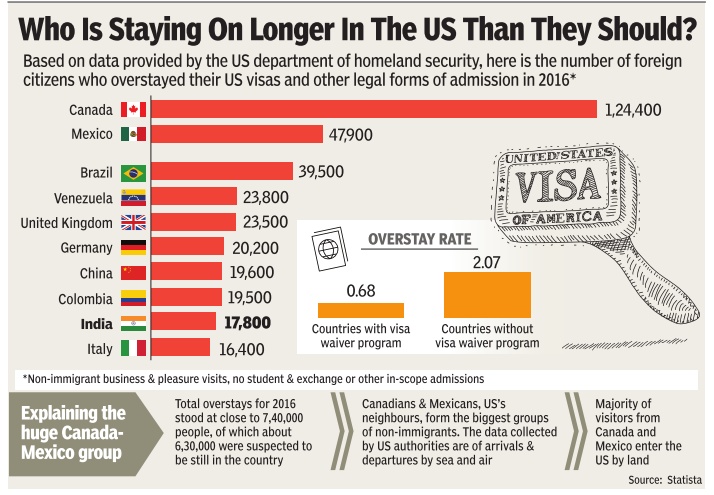
Over 14,000 of the 8.8 lakh Indians on business or tourism visas overstayed in the US last year, according to official figures.
And in 2014, of the 7.6 lakh Indians who were supposed to leave the country before the expiry of their B1B2 visas, 11,653 of them overstayed in the Unites States, the department of homeland security (DHS) said. Overstaying means a non-immigrant who was lawfully admitted to the US for an authorised period but stayed or remains in the country beyond his or her lawful admission period.
According to the `Entry Exit Overstay Report' released by the DHS, in fiscal 2015, of the nearly 45 million nonimmigrant visitor admissions through air or sea ports of entry that were expected to de part in FY 2015, 527,127 individuals overstayed their admission, for a total overstay rate of 1.17%. In other words, 98.83% had left the US on time and abided by the terms of their admission, the report said.
The report does not include students on F-1 visa or those who arrived on work visas like H1B. In FY 2015, of the nearly 45 million nonimmigrant visitor admissions that were expected to depart, DHS determined that 527,127 individuals overstayed their admission, for a total overstay rate of 1.17%. In other words, 98.83% had left the US on time and abided by the terms of their admission. In its report, DHS said several countries with ties to terrorism had significant numbers of nationals still in the US accounted for by the federal government.
2016: 30,000 Indians overstayed
30k Indians overstayed in US last year: Report, May 23, 2017: The Times of India
About 1.4 million Indians travelled to the US on various visas in 2016, out of which over 30,000 overstayed in the country , according to an annual official report.
The department of homeland security submitted the report to the Congress on foreign travellers who entered the US on various visas, including business, tourists, students and visitors exchange, as non-immigrant visitors. As per the report, more than 50 million nonimmigrants were expected to depart from the US in 2016. Of these, 739,478 overstayed their admission, resulting in a total overstay rate of 1.47%.
Of the more than 739,000 overstays, DHS said 628,799 were suspected “in-country“ overstays, meaning there is no record of these foreign nationals leaving the US.
Of these 30,000 Indians who overstayed, a little over 6,000 Indian nationals left the US after the expiry of their visas, the report said. In 2016, more than one million Indians who came to the US on business, tourist or pleasure were expected to leave the country. Of these 17,763 have overstayed in the country , it said.Among the overstayed are 2,040 Indians who departed the US only after the expiry of their visas.
Similarly, as many as 9,897 Indian students or exchange scholars were expected to depart by the end of the year and of which, 4,575 overstayed their legal period.
2016-17: 74% H-1B visa seekers are Indians
At 74%, Indians top H-1B visa seekers, Chinese distant 2nd, August 20, 2017: The Times of India

2.4L Indians Have Filed Applications Till June 30
With 2.47 lakh applications, Indians continued to be the largest group of H-1B visa aspirants during the first nine months of the current US financial year. The number works out to 74% of the total applications between October 1, 2016, and June 30, 2017. The US financial year begins from October 1 and ends on September 30. During 2015-2016 financial year, Indians had filed 3 lakh applications.
Though the number of Chinese H-1B aspirants is much lower by comparison, their visa applications till June 30 stands at 36,362 -their highest-ever over the past 10 financial years. A total of 35,720 applications were filed by the Chinese during 2015-16. Canada came third with 3,551 applications till June 30,2017.
The US received 3.36 lakh applications for H-1B visas till June 30, of which 1.97 lakh have been approved. The US Citizenship and Immigration Ser vices, which released this data, said many applications were still pending approval.
While a breakup of the applications approved based on the country of birth is not available till June 30, 2017, the USCIS report for 2015-16 shows that of 3.45 lakh approved applications, 74% -or 2.56 lakh -were from India. China was at a distant second with 9% or 31,995 approvals. A section of US senators has pointed out that with Indians flooding the application pool, they do stand to benefit in terms of the number of visa approvals granted.
From October 1, 2006, to June 30, 2017, Indian applications stood at 21.83 lakh, the Chinese at 2.96 lakh and those from Philippines at 85,918. Applications from Philippines has shown a decline of 70%. Canada came fifth in the list with 68,228 applications. The number of Indians applying for H-1B has increased by 80.6% since 2006-07 to stand at three lakh in 2015-16.
The technology sector continues to dominate H-1B visa applications. The top five firms to whom the visas were granted till June-end included Cognizant (US Corp), Infosys, TCS, Accenture and Wipro.The average salaries of these firms were well below the minimum salary for H-1B visa holders of $130,000 that was proposed in a reform bill.
EB-5 visas /cash for green cards
2016-18: 300% increase
Lubna Kably, 300% jump in 2 yrs in desis ‘buying’ green card, March 21, 2019: The Times of India
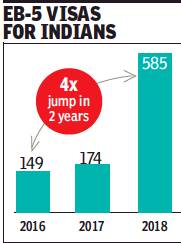
From: Lubna Kably, 300% jump in 2 yrs in desis ‘buying’ green card, March 21, 2019: The Times of India
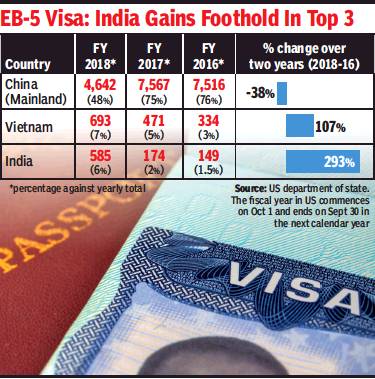
From: Lubna Kably, 300% jump in 2 yrs in desis ‘buying’ green card, March 21, 2019: The Times of India
The number of Indians getting investment linked EB-5 visas in the US, also known as “cash for green card”, has risen nearly fourfold in the past two years.
According to statistics issued by the US Department of State, 585 such conditional green cards were issued to Indians during the 12-month period ending September 2018, as against just 174 in the fiscal year 2017.
Compared with the allotment of 149 conditional green cards during fiscal 2016, this reflects a massive increase of 293% over a two-year period. In terms of the number of visas granted, India has overtaken South Korea and Taiwan to take the third spot behind mainland China and Vietnam in fiscal 2018.
Over the past few years, hundreds of Indians, including those already working in the US have been lining up to apply for EB-5, an investment linked visa.
The wait seems to have borne fruit, going by the huge jump in numbers in the last fiscal year.
The EB-5 program requires an investment of $1 million and creation of at least 10 jobs in the US. This requirement drops to $500,000 for investments in certain targeted areas of employment.
Investments via regional centres that pool in money for various projects, especially in the American real estate sector, are far more popular than setting up one’s own operations. After holding a conditional green card for 21 months, an investor can apply for permanent residence, subject to fulfilment of conditions.
With EB-5 visas, Indians looking beyond H-1B route
Interest from Indians for the EB-5 visa has spiked in recent years, given that obtaining H-1B visas, including extensions, are now more difficult. “Extension of H-1B visas are also being subject to the same rigorous scrutiny with denial rates on the rise,” says Mitchell L Wexler, partner, Fragomen, a global immigration law firm.
“Also boosting the demand is the fact that work authorisations available to certain category of H-1B spouses will be rescinded. Children of several H-1B workers, especially those who are in the queue for a green card under the employment category, are also aging out. Post 21 years, they can no longer hold the dependent H-4 visa, but need to migrate to another visa (say student visa) or self-deport to India,” says Wexler. Given the backlog which Indian investors could face in the near future under EB-5, investments must be planned in advance to protect the child’s interest,” he adds.
TOI has reported earlier that even rich families based in India tend to gift the investment sum to a child studying in the United States. After completion of studies, the EB-5 visa enables him or her to work without having to throw the hat in an H-1B lottery.
Only 10,000 EB-5 visas are issued annually, with a 7% per country cap. If a country doesn’t meet the cap, the unused visa quota is redistributed to other countries. Currently, Chinese and Vietnamese investors are facing a retrogression (which arises when the applications exceed the cap set) and the waiting time for Chinese is nearly 14 years. The current waiting period for Indians, to obtain a conditional green card after making an investment ranges roughly between 18 and 30 months, depending on how fast the application (I-526 petition) is approved.
Indian investors too could face retrogression from July or August this year, which would increase the waiting time further by a few years. This will still be significantly shorter than the wait time for standard employment-based green card applications where the waiting time is upward of 17-plus years.
The US department of state has also released figures of pending applications, as of September 30, 2018. The maximum pending applications were from China at 8,180, followed by 1,633 applications from India.
A proposed hike in investment limits and recent investor scams has made investors more careful, but the interest has not waned.
2018: 10% drop in H-1B visa approvals
June 5, 2019: The Times of India
10% drop in H-1B visa approvals in 2018: US authorities WASHINGTON: The year 2018 registered a sharp 10% decline in the approval of H-1B visa, which is popular among highly-skilled Indian IT professionals, according to the US authorities. The US Citizenship and Immigration Services (USCIS) approved 335,000 H-1B visas, which included both new and renewable, in the fiscal year 2018. This was 10% less from 373,400 in the previous fiscal year of 2017, according to the USCIS's annual statistical report.
The approval rate of H-1B declined from 93% in 2017 to 85% in 2018.
"This administration has aggressively pursued strategies to clamp down on use of the H-1B programme, and these efforts are now showing in the data," Migration Policy Institute analyst Sarah Pierce was quoted as saying by The Mercury News.
For the first six months of this fiscal year, the overall H-1B approval rate for new and continuing visas continued to plummet to 79% by the end of March, down from 85% last year, the daily reported.
The H-1B visa programme is the main vehicle through which US employers can sponsor skilled foreign workers for admission.
According to the latest statistical annual report, in 2018, the USCIS completed 396,300 H-1B application as against 403,300 in 2017. In 2018, 396,300 H-1B beneficiary petitions were processed, which is 13% more over the five fiscal years and two% less from 2017, the report said.
In 2018, the USCIS completed 850,000 naturalisation requests, a five year high and granted 1.1 million green cards.
The H-1B visa, popular among Indian IT professionals, is a non-immigrant visa that allows US companies to employ foreign workers in speciality occupations that require theoretical or technical expertise.
2019: Indians account for 93% of US H-4 visa
Nov 22, 2019: The Times of India
Foreign minister S Jaishankar told Rajya Sabha that the United States wanted to review its 2015 decision to make work visas available to spouses of H-1B visa holders and that Indians accounted for 93% of what is officially known as H-4 visa. The foreign minister also said that India was trying to convince the US that tapping into the Indian talent pool was important for mutual benefit.
“There was some controversy whether H-4 visa programme will be continued but right now it is continuing...There is a court order to the effect that it should be continued but the Trump administration has indicated that it may review it,” he said, replying to a query on spouses of H-1B holders. “We are constantly in touch with the US system, the US government, members of the Congress to convince them that tapping into the Indian talent pool is for our mutual benefit,” he said. “With regard to seven major Indian employers there is no disqualification on any of them. The number of visas for which they have applied to has come down in the last two years. Denial rates have also gone up,” he said. TNN
See also
Indians in the USA
